What Are Some Animal Populations That Will Be Harmed By Climate In Change
Ekta Vishwakarma // Shutterstock
Polar bears and fifty other species threatened by climate change
Climatic change has emerged as a more than urgent consequence than e'er, especially considering the Trump administration's moves to curlicue back Ecology Protection Agency guidelines on carbon emissions, including those for coal-fueled power plants, as well equally relaxing fuel efficiency standards put in place past the Obama administration.
Animals such as koalas, sea turtles, and polar bears find themselves at the middle of the crunch, and those iii are just a outset. Some reports say a 3rd of the earth's fauna species will get extinct by the center of the century if humans continue to release harmful greenhouse gases at the current rate. A recent U.Northward. report puts the number at as many as 1 one thousand thousand species at risk of extinction due to climate change, and species loss is occurring exponentially faster than it has in the past due to homo activeness. Land apply changes currently account for some of the accelerated extinction, but more and more than, climate alter is becoming a bigger force in putting certain animals on the endangered species list.
Some animals are able to adapt to alterations in temperature and weather, but others can survive or feed merely in certain climates. Accept the polar deport, which depends on sea water ice for hunting and mating. Scientists note that climate modify is causing sea ice to disappear at an alarming rate, threatening the polar conduct'south survival. Losing the polar bear, also as other plants and animals, is not but a deeply tragic loss: It has huge ramifications for homo life as well. The same U.North. report noted that this loss of biodiversity threatens food and water supplies besides equally other resources that humans count on for survival.
Read on to larn most 50 of the globe's animal species that fall into the categories of vulnerable, endangered, and critically endangered due to climate alter.
Story updated past Isabel Sepulveda.
You may also like: fifty of the world'southward well-nigh endangered species
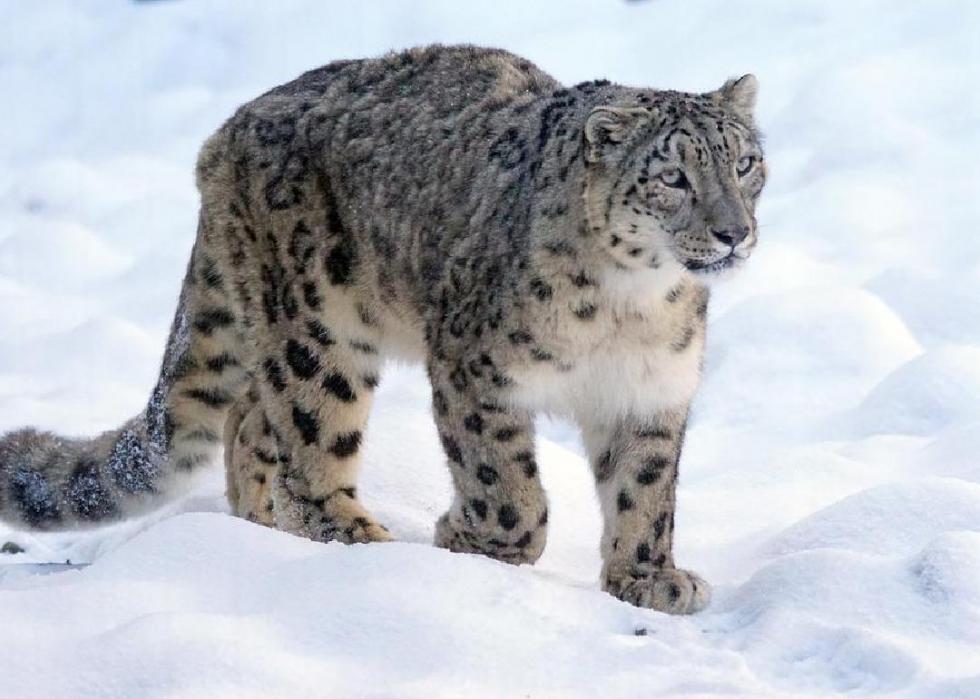
ane / 51
Snow leopard
These alpine felines can be found in the mountains of China, Nepal, and Bharat, among other Asian countries. The World Wildlife Fund (WWF) classifies the snow leopard as vulnerable and cautions that treeline shift from greenhouse gases could significantly deplete the animal's habitat. Dwindling populations of this big true cat'due south prey, such as pikas and hares, also play a office in its status. Although the leopard has gone from "endangered" to "at risk," the species is still slated to lose about 10% of its population over the next three generations.
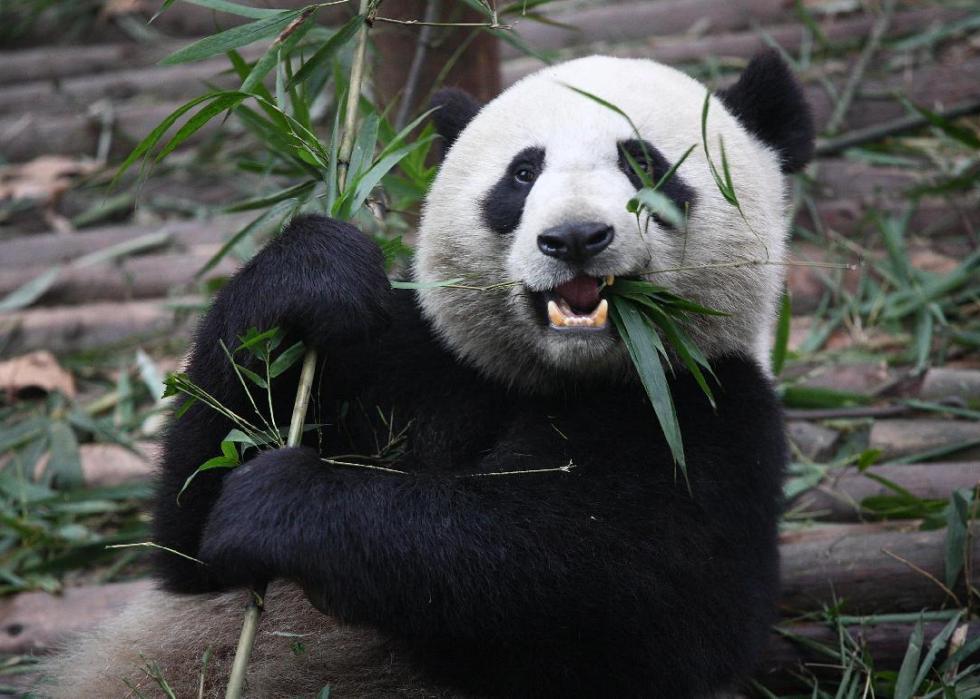
ii / 51
Chen Wu // Wikimedia Commons
Giant panda
This vulnerable species of carry—and longtime logo of the WWF—dwells mainly in bamboo forests in the mountains of Western China. Increasing temperatures cause the panda'south chief nutrient source, bamboo, to abruptly flower and die, which causes the bears to seek culling areas to feed and live. In order to maintain a good for you nutrition, pandas must swallow 26 to 84 pounds of bamboo every day.
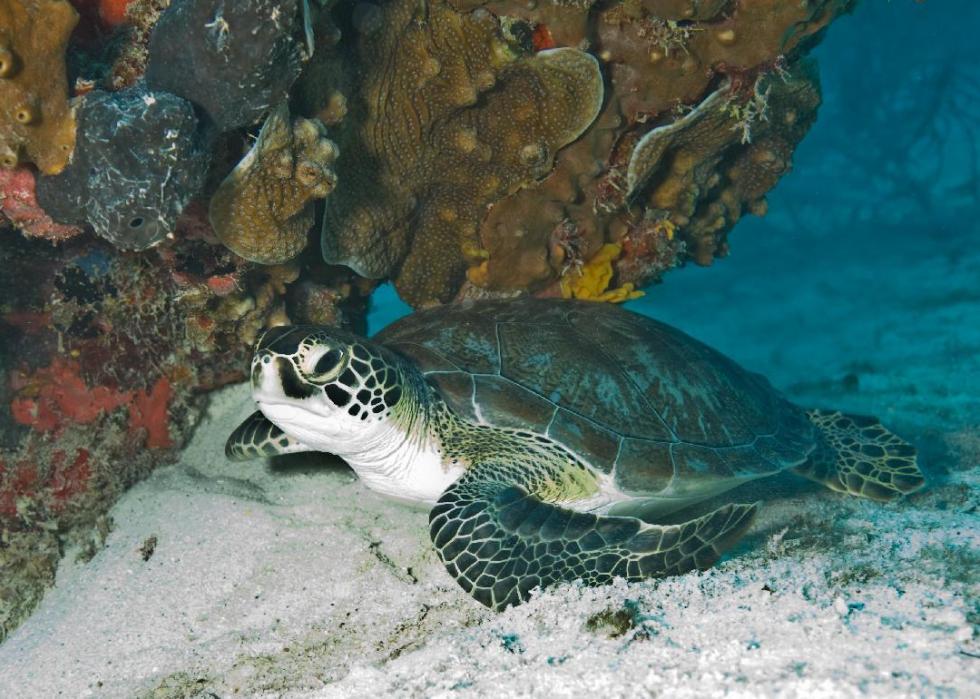
3 / 51
National Park Service Due south Florida // Wikimedia Eatables
Green bounding main turtle
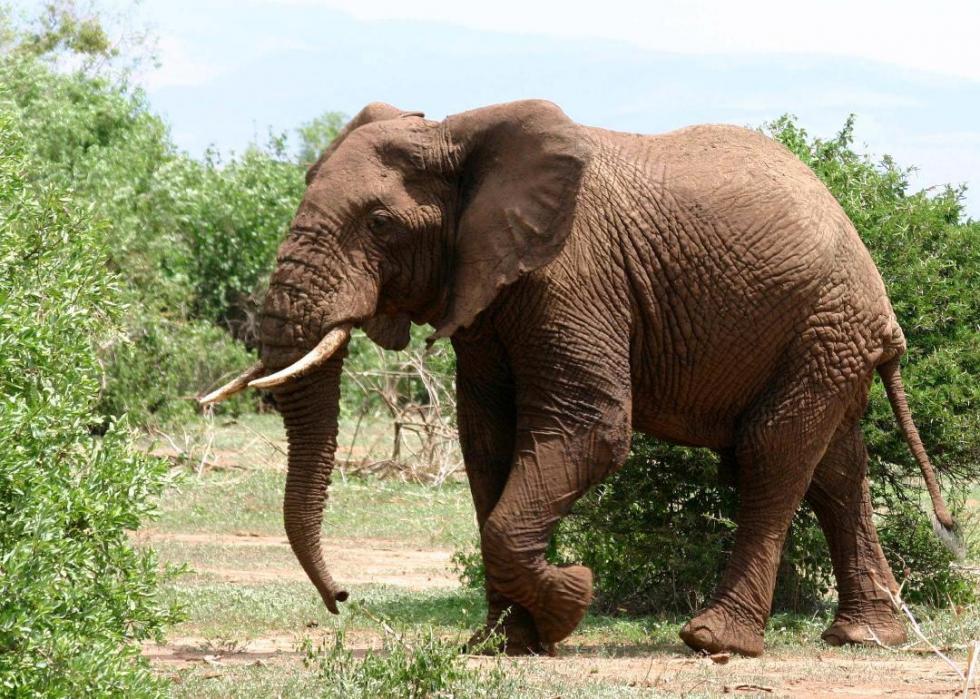
four / 51
Charles J Sharp // Wikimedia Commons
African elephant
These Africa-dwelling house giants are divided into two subspecies: the savanna elephant, which resides in planes and woodlands, and the smaller wood elephant, which inhabits central and western African equatorial forests. These elephants, classified as vulnerable, are sensitive to the heat, and continued global warming dampens the animal'south power to reproduce. Confined dispersal due to habitat fragmentation, along with modest genetic diversity, affect the elephant's ability to adapt to ascension temperatures. Possibly the most important cistron in the African elephants' survival is their need for a great deal of freshwater, which straight affects their reproduction and migration.
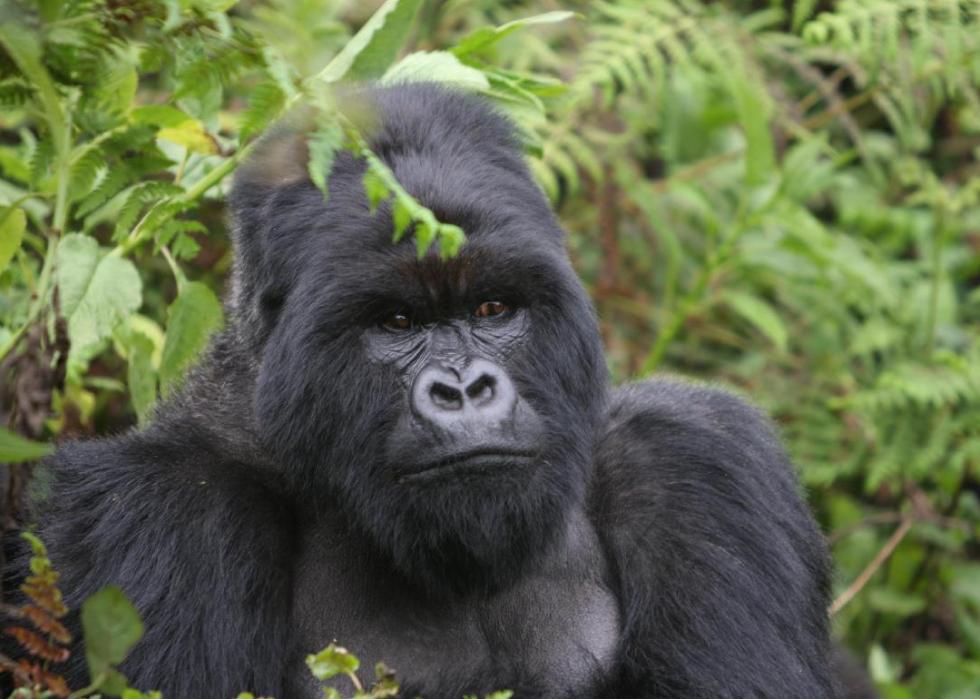
5 / 51
U.Due south. Fish and Wildlife Services Headquarters // Wikimedia Commons
Mountain gorilla
Native to the mountains of Uganda, Rwanda, and the Congo-kinshasa, the remaining mount gorillas are now protected in Bwindi Bulletproof National Park, Mgahinga Gorilla National Park, Volcanoes National Park, and Virunga National Park. In the wild, ascension temperatures threaten to shift certain types of plants to higher elevations, leaving the critically endangered gorilla with fewer nutrition options. In guild to conform to irresolute weather, the gorilla habitats may demand to be expanded beyond these parks.
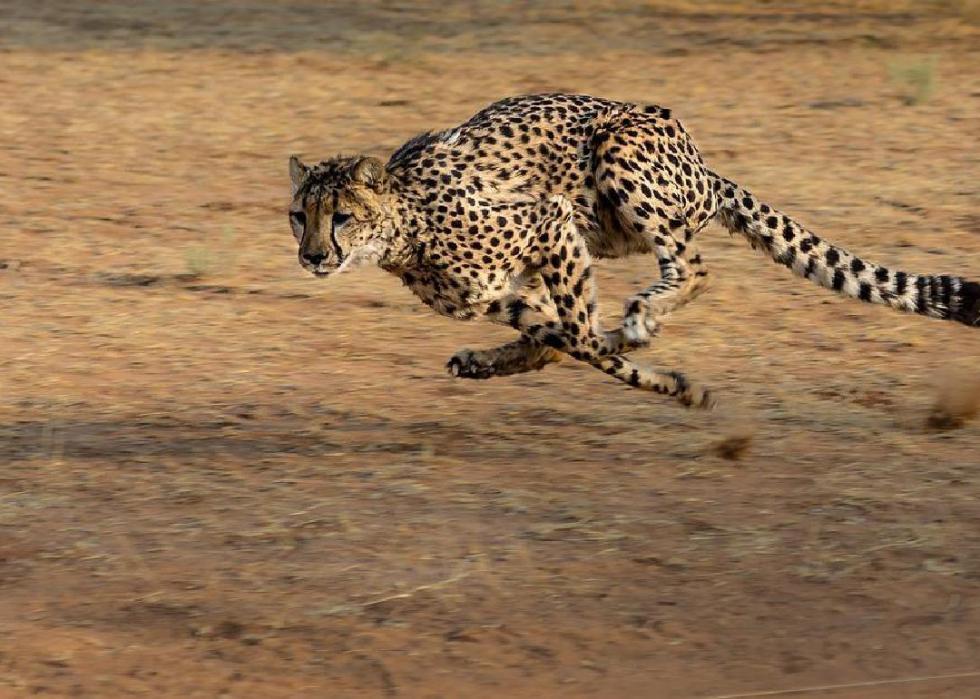
6 / 51
Cheetah
This speedy big cat makes sub-Saharan Africa its home, only it can also be found in southern Algeria and northern Niger. Rising temperatures apparently have caused the male person chetah'southward sperm to develop abnormally and has diminished male testosterone levels, impacting the animal's ability to reproduce. Also, climatic change has taken a toll on the gazelle, one of the cheetah's favorite meals. As such, the feline has to seek out herbivore options that are lower in protein than the gazelle. Because its largest population hovers at around 3,500, the cheetah is considered vulnerable—though some scientists merits it should be listed as endangered.
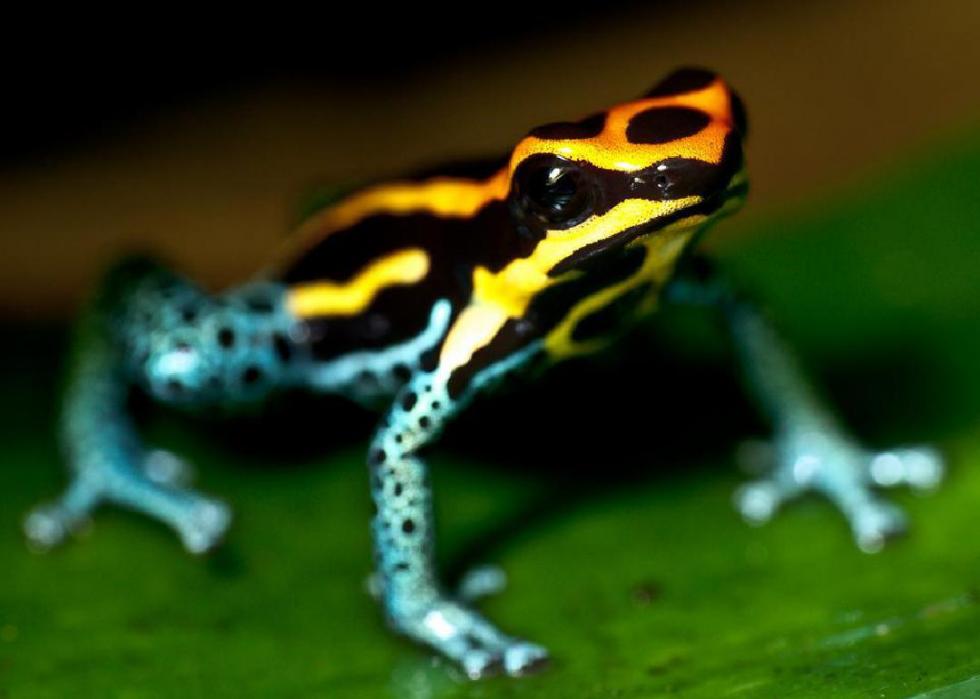
7 / 51
Poison dart frog
Residing mainly in the rainforests of Cardinal America and South America, this critically endangered species of frog, similar all frogs, relies on water to sustain itself in tadpole form. As temperatures continue to shoot upwardly due to global warming, sources of water start to diminish in some rainforest areas, which threatens tadpoles' survival. Human activities that crusade habitat fragmentation make it even harder for species such as this to withstand changes in climate. The poisonous substance dart frog has only one natural predator, a serpent that is immune to the frog's toxicity.
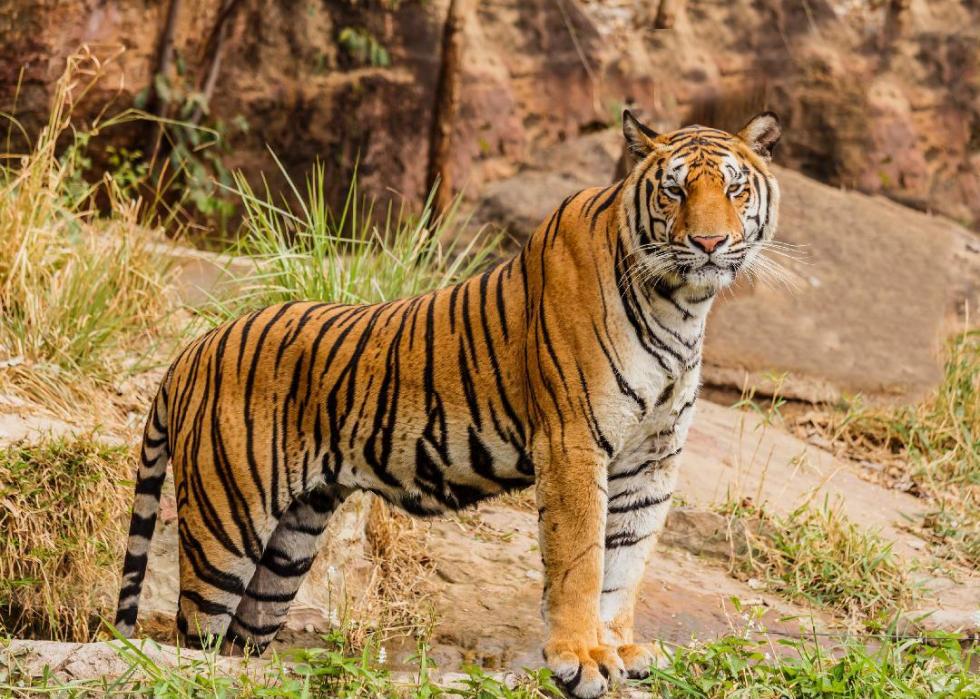
eight / 51
Derrick Brutel // Wikimedia Commons
Tiger
This endangered big cat roams the tropical and woodland forests of eastern Russia, India, Bangladesh, and Nepal, amidst other Asian countries. Several climate-related factors contribute to the tiger's endangered status: Rising body of water levels impinge on littoral habitats for Bengal tigers; changing temperatures encroach on habitats for Siberian tigers, ultimately causing fewer feeding options; wildfires threaten to diminish Siberian tiger domicile places and food sources; and, although human-caused, deforestation contributes to changing climates. That doesn't bode well for the Sumatran tiger, which is nearing extinction.
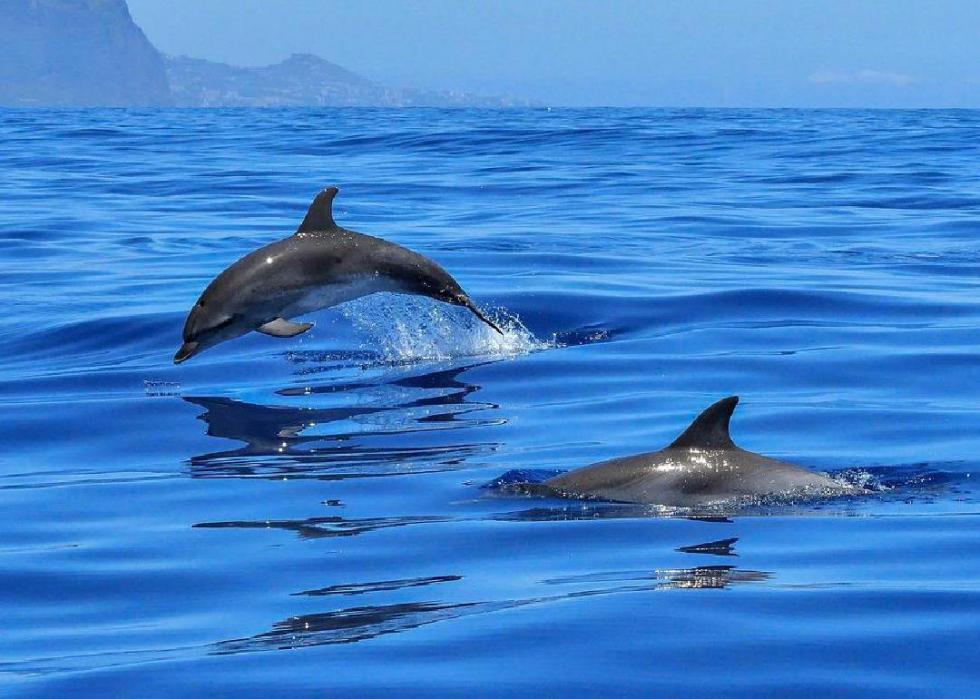
nine / 51
Dolphin
Found in Due south American waters likewise equally the Chill, dolphins of all types are threatened by climate change. As global warming relentlessly ratchets upwards ocean temperatures, populations of some dolphin prey have started to decrease. Changing ocean currents as well affect the distribution of fish on which dolphins feed, as well equally channels in which dolphins migrate. Sixteen species of dolphins (and whales) are categorized in danger of extinction, such as the New Zealand Maui dolphin and several types of river dolphins.
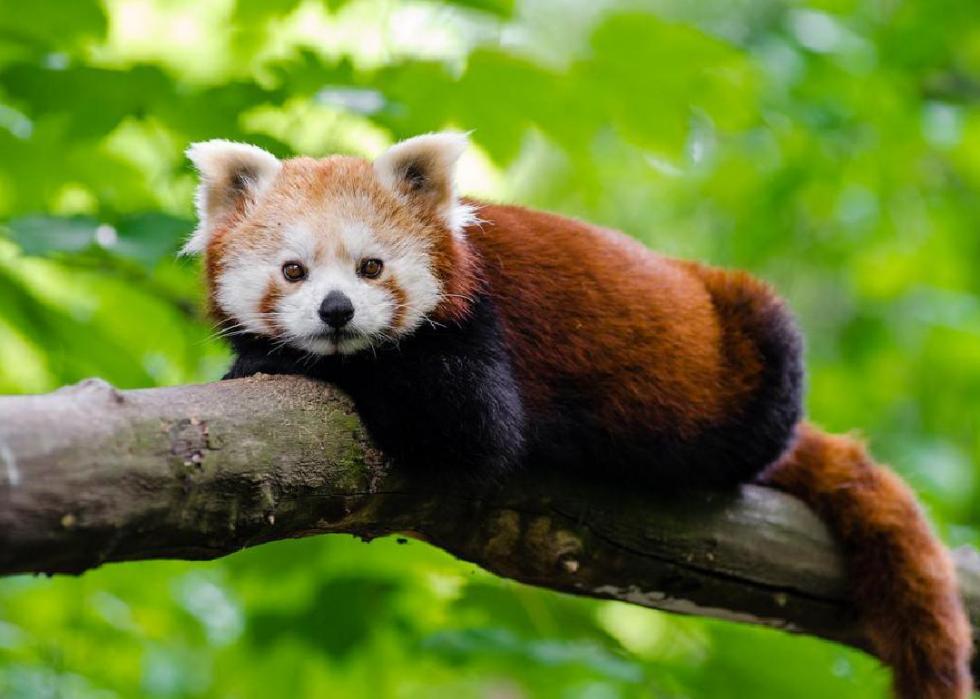
10 / 51
Ruddy panda
These herbivorous creatures are also called the "bottom panda" and "crimson comport-cat," and live mainly in the eastern Himalayas. Red pandas have been classified as endangered as they face up the deposition of their main food source: bamboo. This leads to habitat loss and fragmentation, like to the effects on the giant panda.
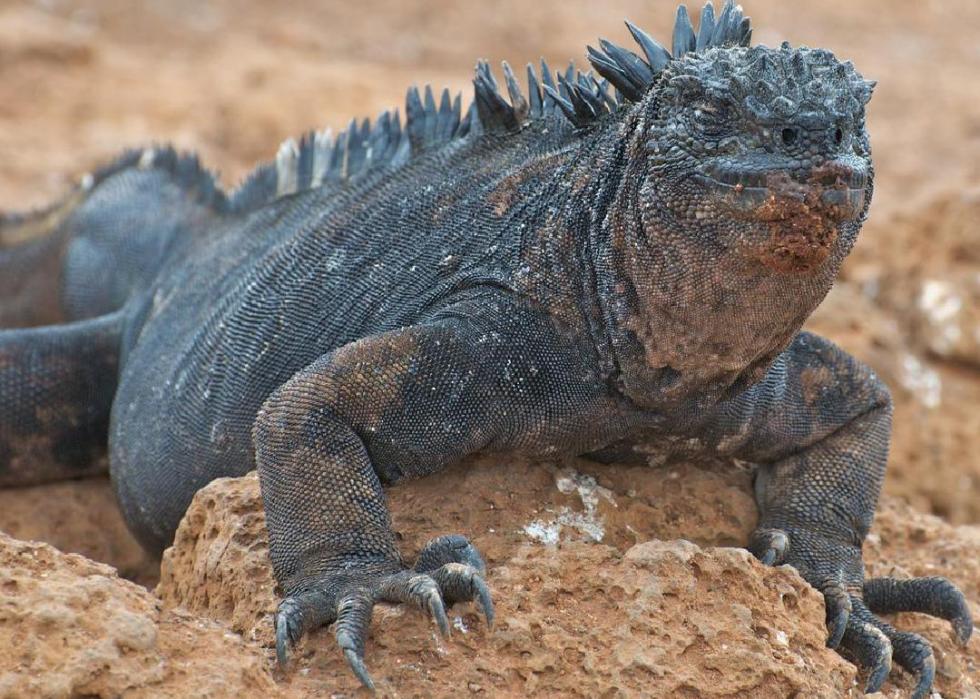
11 / 51
Marine iguana
Warming oceans cause an array of problems for aquatic and marine animals. In the example of the Galapagos-dwelling marine iguana, ascension ocean temperatures have been killing algae, causing many of these lizards to starve. Elevating sea and air temperatures likewise contribute to these coastal iguanas' vulnerable status. Warmer weather can interfere with their ability to regulate body temperature, and it can tamper with their beach-nesting and egg development.
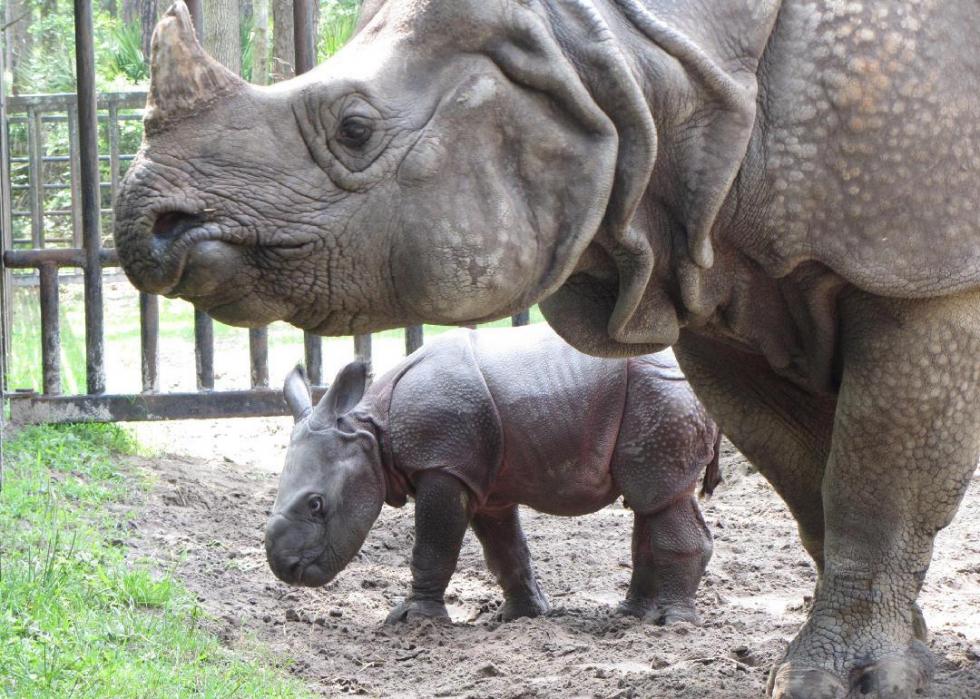
12 / 51
Michaelstone428 // Wikimedia Eatables
Greater one-horned rhino
One-horned rhinos alive in tropical and subtropical grasslands in the north of the Indian subcontinent. Though miraculously brought back from the brink of extinction a couple of decades ago, the animal is however flagged as vulnerable partly considering of the growth of an invasive weed, nicknamed "mile a infinitesimal weed," which wipes out grasses and tree saplings integral to the rhinoceros's diet. Rising temperatures are likewise taking a price. Rhinos demand to absurd down in large pools of water, which are becoming more and more scarce.
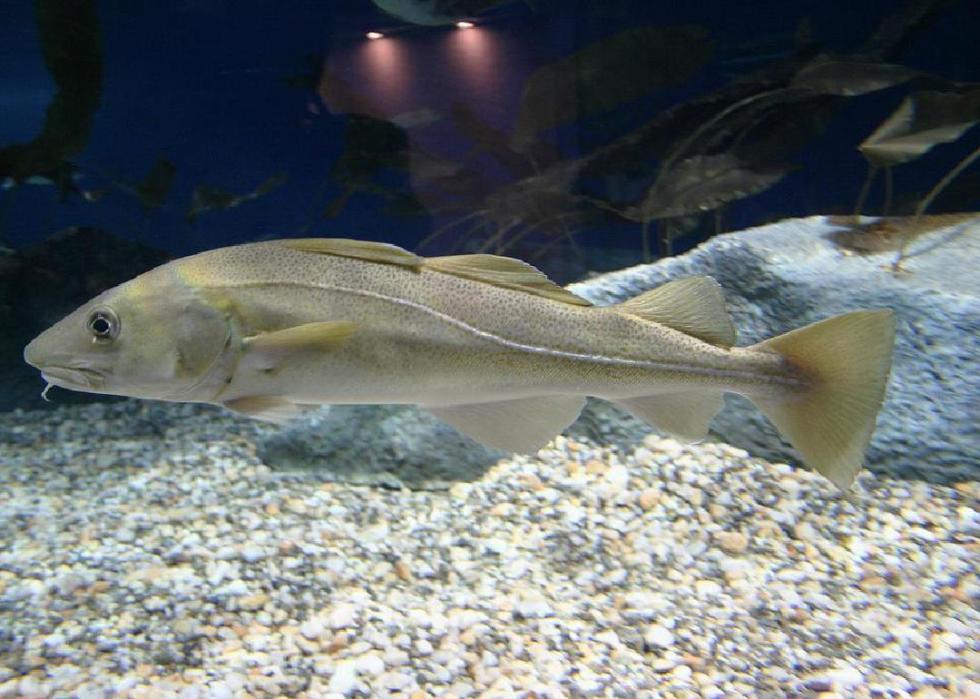
13 / 51
Maritime Aquarium at Norwalk // Flickr
Atlantic cod
The Atlantic cod'south preferred habitat is correct in its proper name. In North America, they can exist found in Atlantic waters from Cape Cod to northern Labrador. These fish need relatively cool waters to thrive, at temperatures betwixt 32 and 53 degrees Fahrenheit, and the cod's size and reproduction habits are directly continued to water temperature. At extremes in either direction, cod tend to swallow less and to not abound as big, and in warmer water, they tend to mature more slowly and to reproduce before. And so it'south no surprise that cod populations have been dropping due to rising bounding main temperatures. The International Union for the Conservation of Nature categorizes the Atlantic cod as vulnerable.
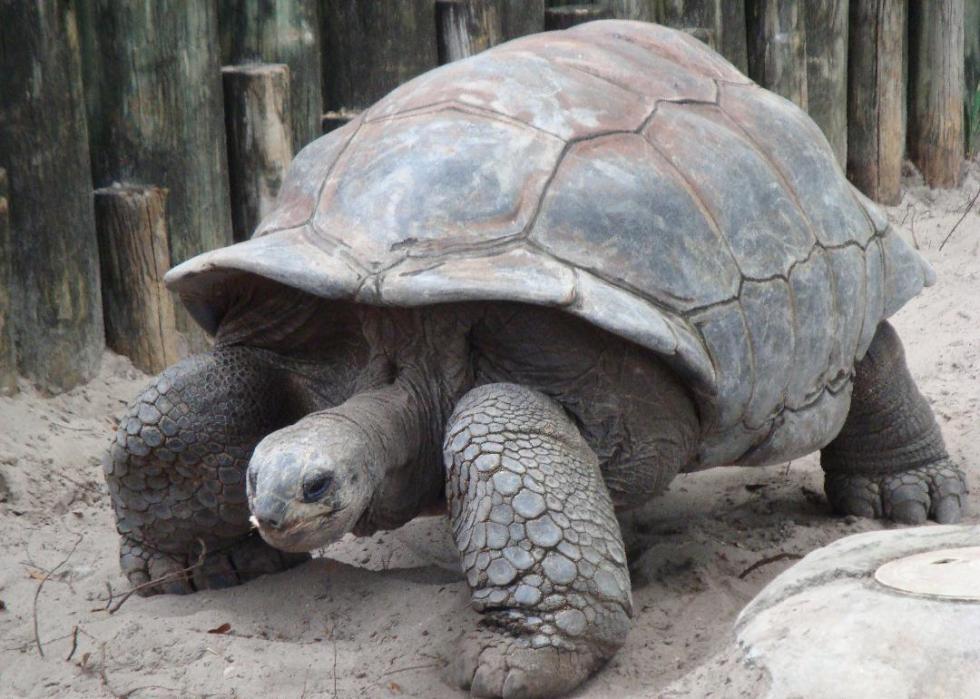
14 / 51
Childzy // Wikimedia Commons
Behemothic tortoise
Native to the Galapagos islands, this massive reptile has been forced to migrate due to rising temperatures, which may negatively touch its power to nest. Drought has also played a role in the tortoise's classification as vulnerable, at times leaving the animal with little or nothing to eat.
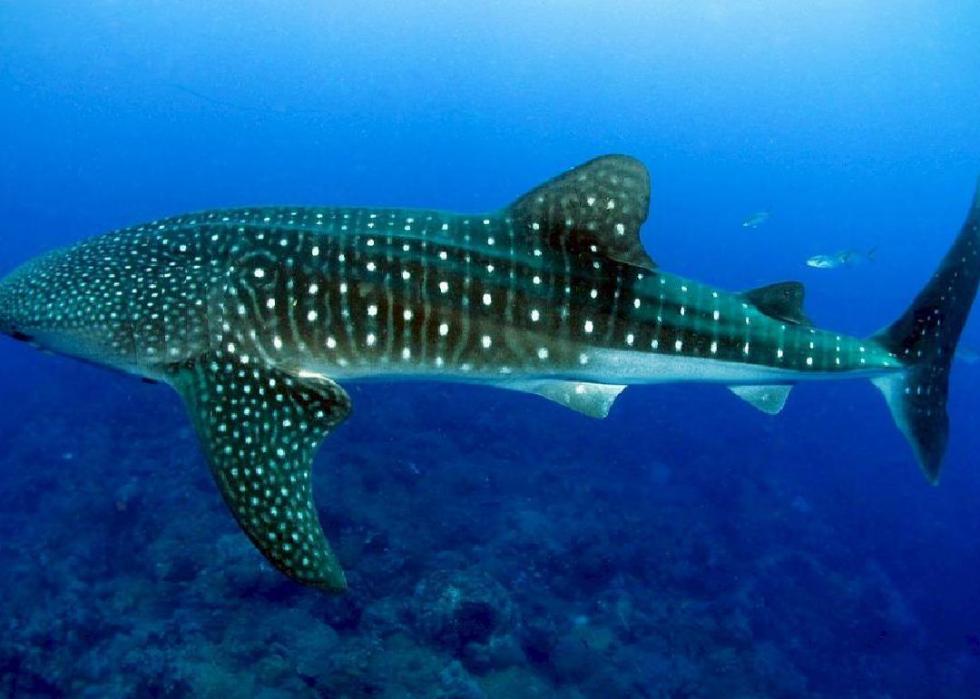
15 / 51
Whale shark
These tropical ocean-dwelling house creatures fall into the endangered category partly due to increasing ocean temperatures—which crusade them to flock to waters effectually the Azores, w of Portugal. Though they tin survive in fairly warm waters, whale sharks still prefer libation body of water temperatures. As water temperatures rise, the time to come for whale sharks could be bleak.
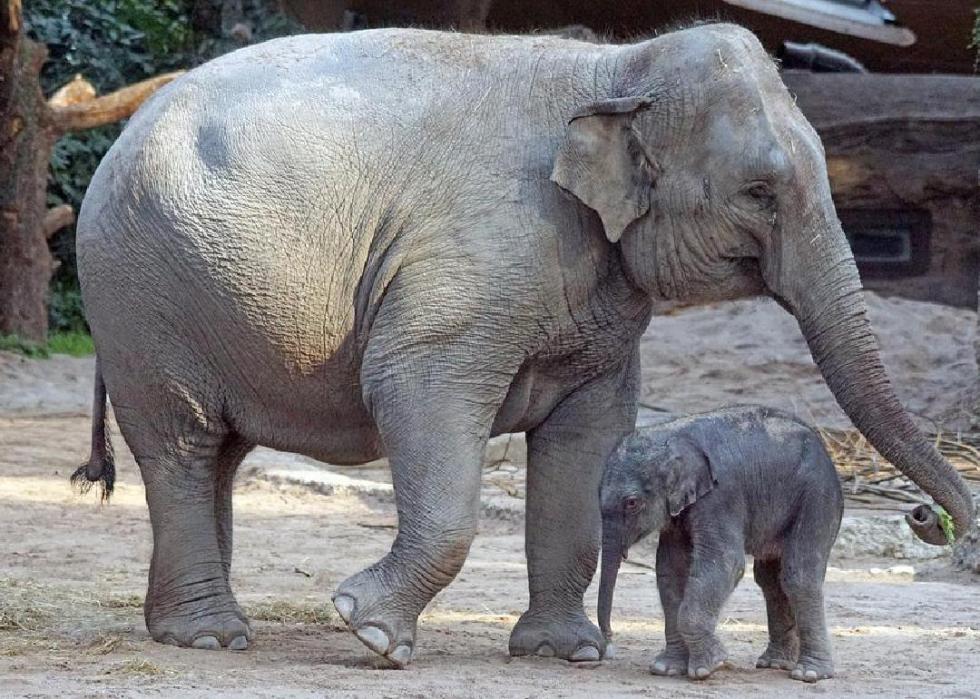
16 / 51
Asian elephant
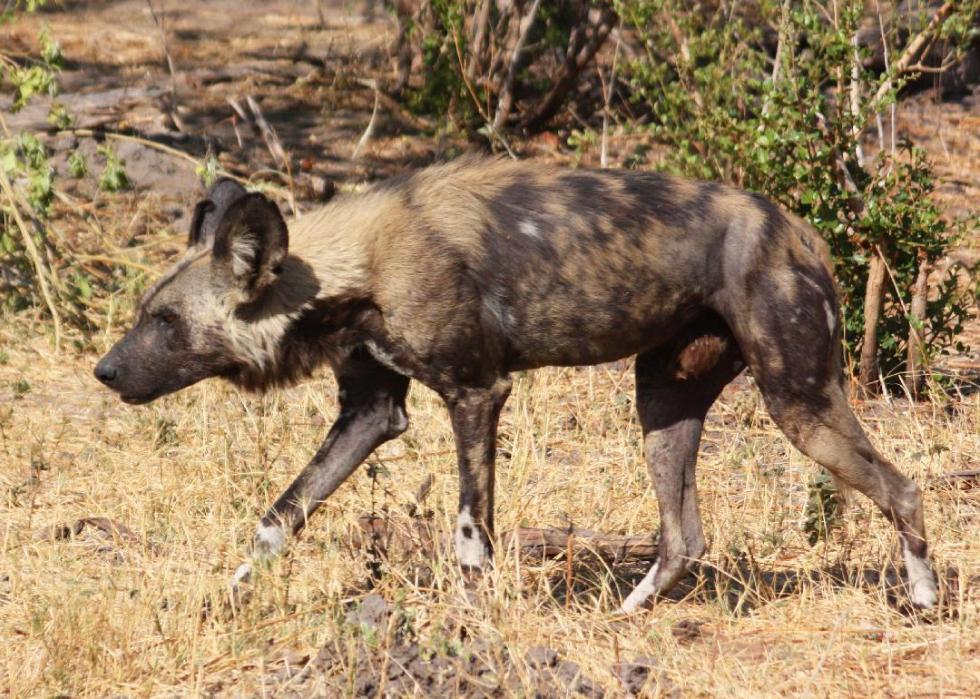
18 / 51
Charles J Sharp // Wikimedia Eatables
African wild domestic dog
1 of the most endangered mammals worldwide, this wild dog roams the southern role of East Africa. Like many land mammals, these dogs don't fare well in excessive rut and don't have the option of heading to libation areas at college altitudes. They need to hunt during the day in club to orchestrate their attacks, and equally temperatures continue to ascent, their number of sufficiently cooler daytime hours to hunt is diminishing. Every bit a result, fewer wild canis familiaris pups are able to survive.
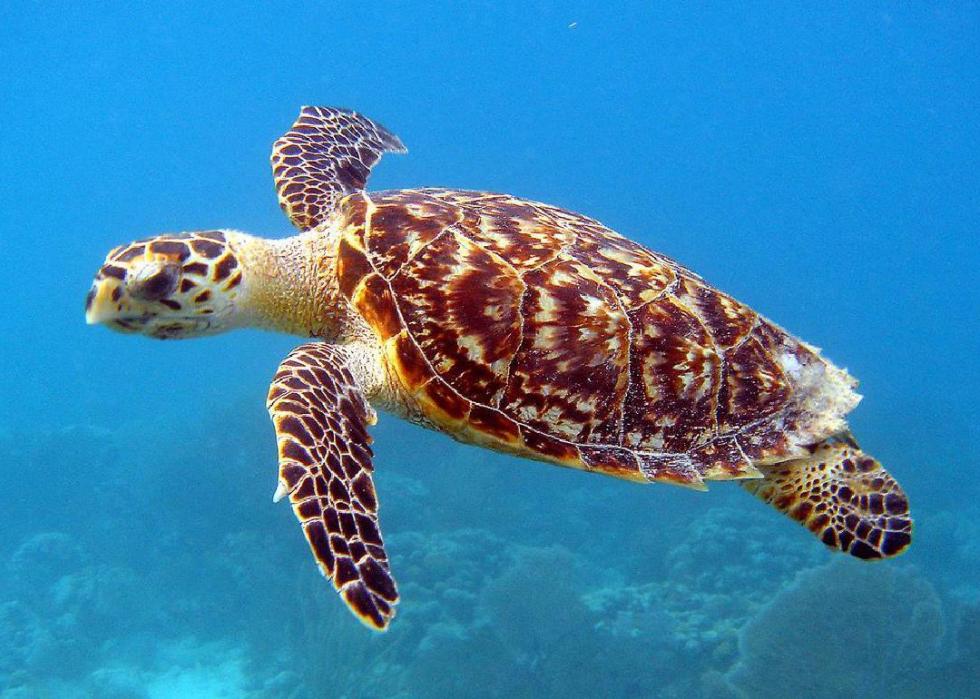
19 / 51
U.Due south. Fish and Wild animals Services South East Region // Flickr
Hawksbill turtle
These critically endangered sea turtles swim in tropical oceans throughout the world and owe their status to ascension ocean temperatures. Similar to the case of the green sea turtle, warmer beaches, where these turtles lay their eggs, pb to the spawning of more female person turtles, limiting genetic diversity. Rising body of water-surface temperatures and changing ocean currents may too contribute to the endangerment of these turtles, because they disrupt migration patterns.
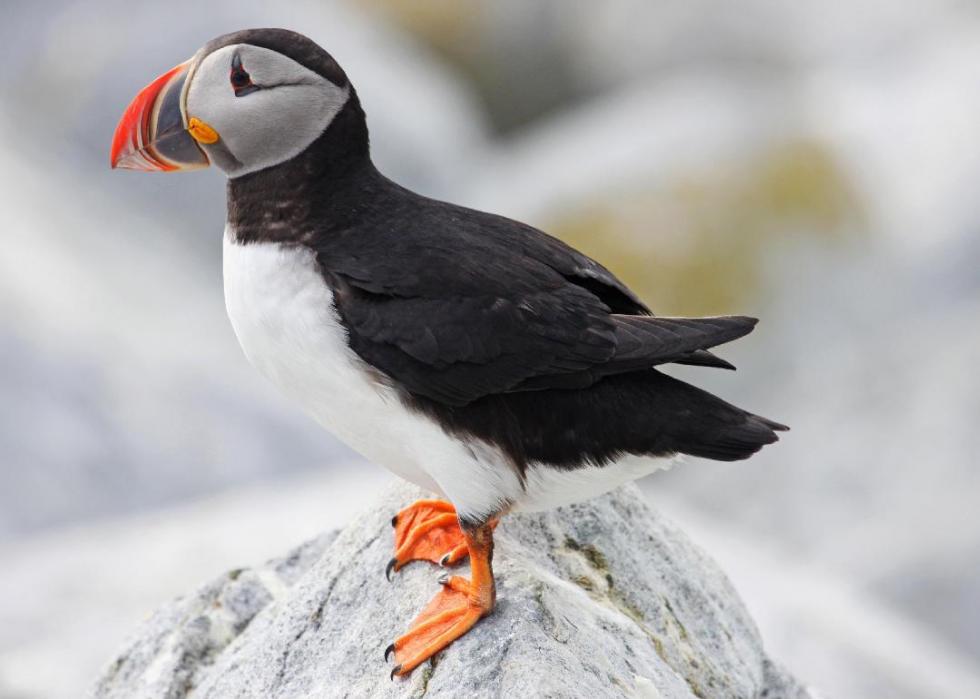
20 / 51
Judy Gallagher // Wikimedia Commons
Atlantic puffin
Rising ocean temperatures, a mutual link betwixt species threatened past climate change, is largely to arraign for this seabird'south vulnerable status. Because of changing fish populations, the Atlantic puffin is unable to feed properly, and survival rates for puffin chicks have been depression. Atlantic puffins inhabit oceans from the eastern Canadian declension to the northeastern U.South. and from the western European coast to northern Russia.
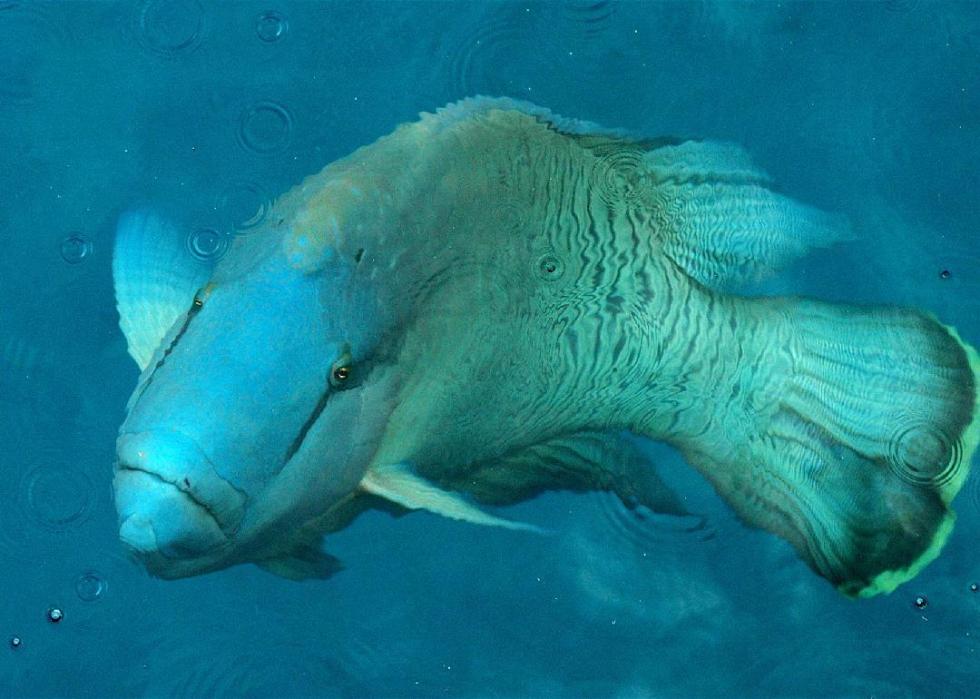
21 / 51
Taro Taylor // Wikimedia Commons
Humphead wrasse
These giants of the coral reef fall into the endangered category because of higher levels of carbon dioxide in the air, which lead to sea acidification and degradation of coral reefs. Some scientists predict that about 70% of coral reefs will be impacted by greenhouse gas emissions by 2030, unless humans brand significant changes to the amount of carbon dioxide emitted into the temper.
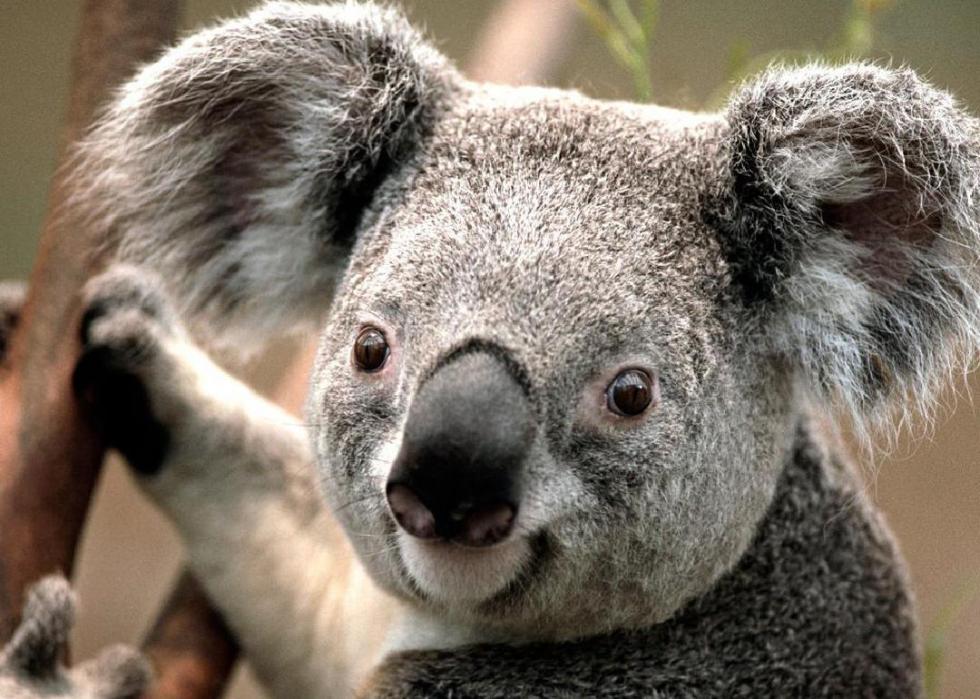
22 / 51
La Butaca Dorada // Flickr
Koala
Intense droughts and bushfires threaten to alter the habitats of this iconic Australian marsupial. Hotter temperatures are, of course, the culprit of these environmental factors, which show detrimental to koalas, as they have little tolerance for extreme heat and lack of water. This combined with habitat fragmentation, commercial hunting, and wild dog attacks makes the koala a vulnerable species.
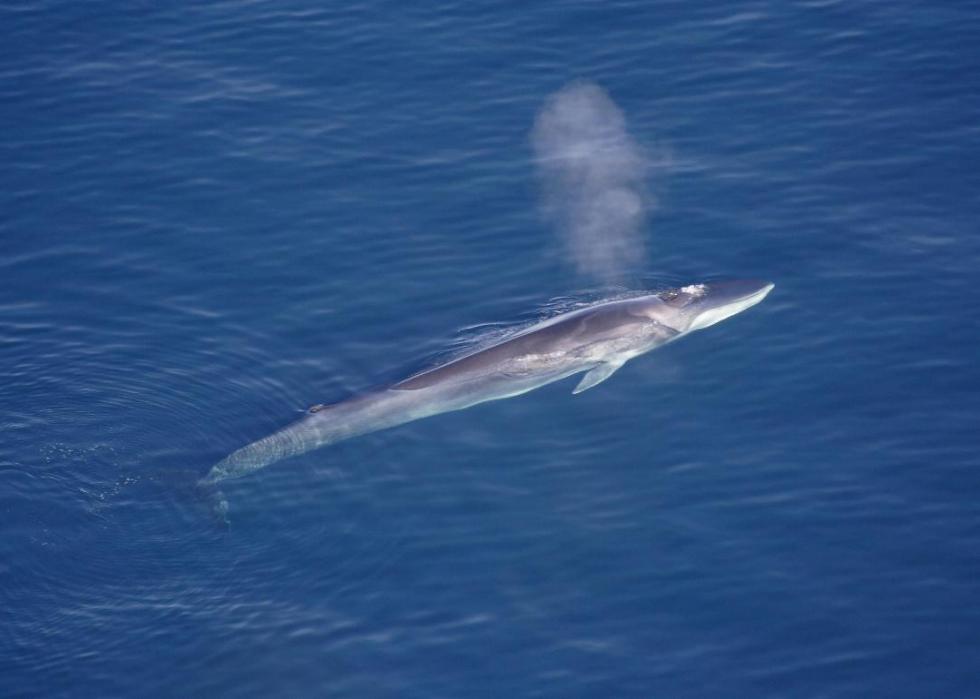
23 / 51
Aqqa Rosing-Asvid // Wikimedia Commons
Fin whale
The 2nd-largest species of whale, the fin whale swims in the Gulf of California, Chill Ocean, and the Coral Triangle. Several climatic factors contribute to this baleen whale's endangered condition. Warming ocean temperatures are killing Antarctic krill and herring, of import parts of the fin whale's diet.
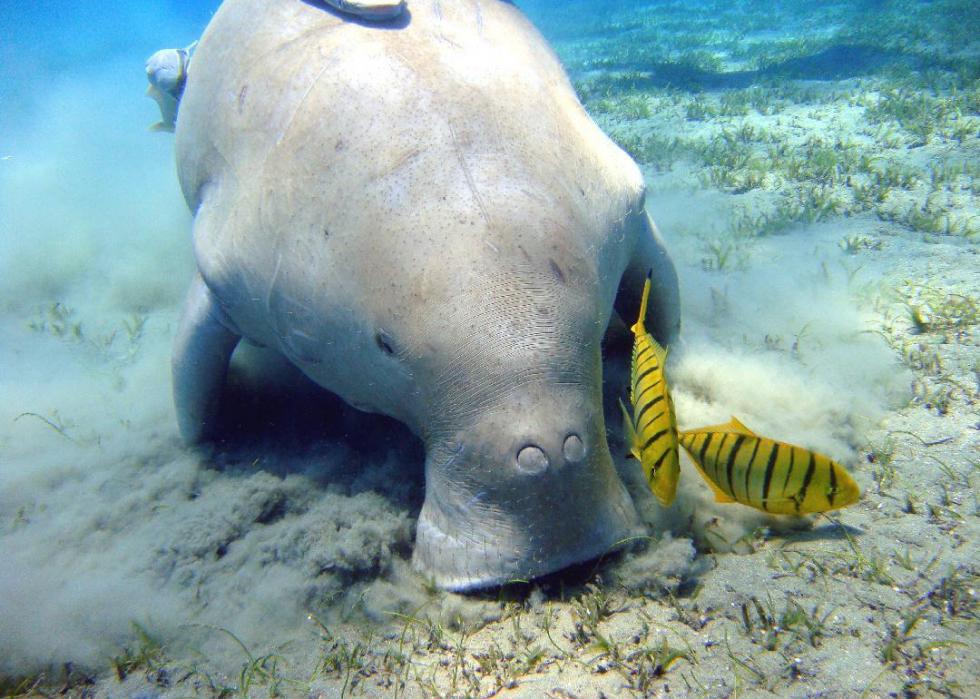
24 / 51
Julien Willem // Wikimedia Eatables
Dugong
Relatively close cousins of manatees, dugongs swim in coastal areas of the Indian and western Pacific Oceans. Information technology's no surprise that these large marine mammals are, like their cousins, chosen sea cows. They are a vulnerable species due in part to environmental threats to their primary nutrient source, seagrass. The largest threats to seagrass growth are floods and storms, just river runoff has also taken a price on seagrass populations.
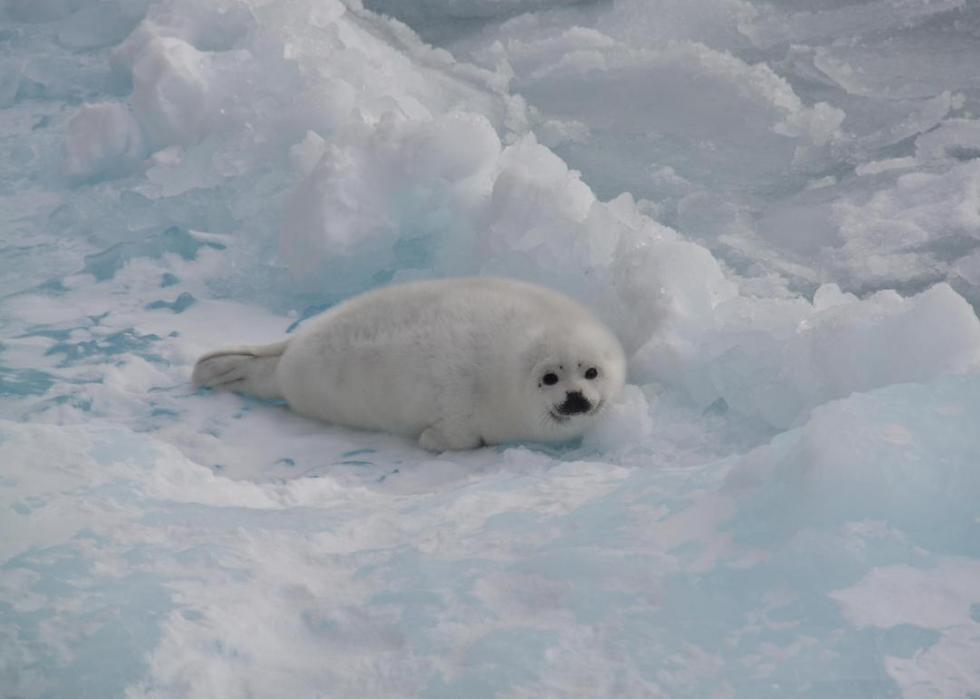
25 / 51
Lysogeny // Wikimedia Commons
Ice seal
Comprised of the ringed, ribbon, bearded, and spotted seals, these chill mammals rely on a dandy deal of water ice to survive. Spiking temperatures and melting water ice tin separate seal pups from their mothers when they still need to feed, and loss of ice also affects the seals' ability to build proper habitats to shelter pups. Several types of ice seals are protected under the Endangered Species Human action.
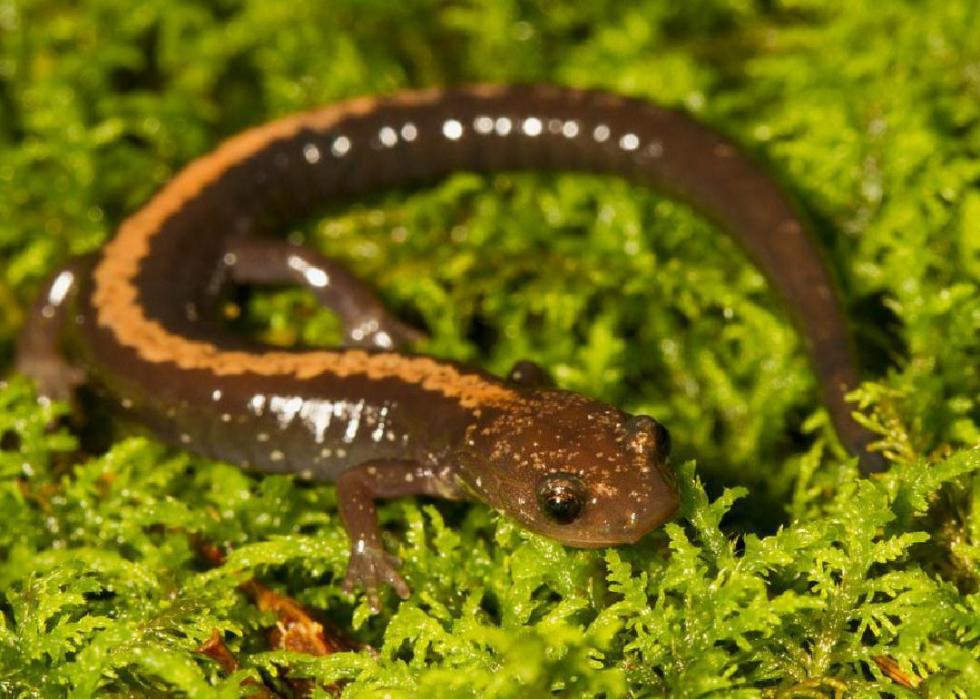
26 / 51
Shenandoah National Park // Flickr
Shenandoah salamander
This vulnerable salamander can exist found only in Shenandoah National Park. At that place, it faces climatic threats, such every bit habitat devastation spurred by invasive insects. Acid deposits accept also altered the chemical structure of the soil containing creatures the salamander eats. This amphibian prefers to dwell in cooler environments, then rising temperatures may impede upon its ability to thrive.
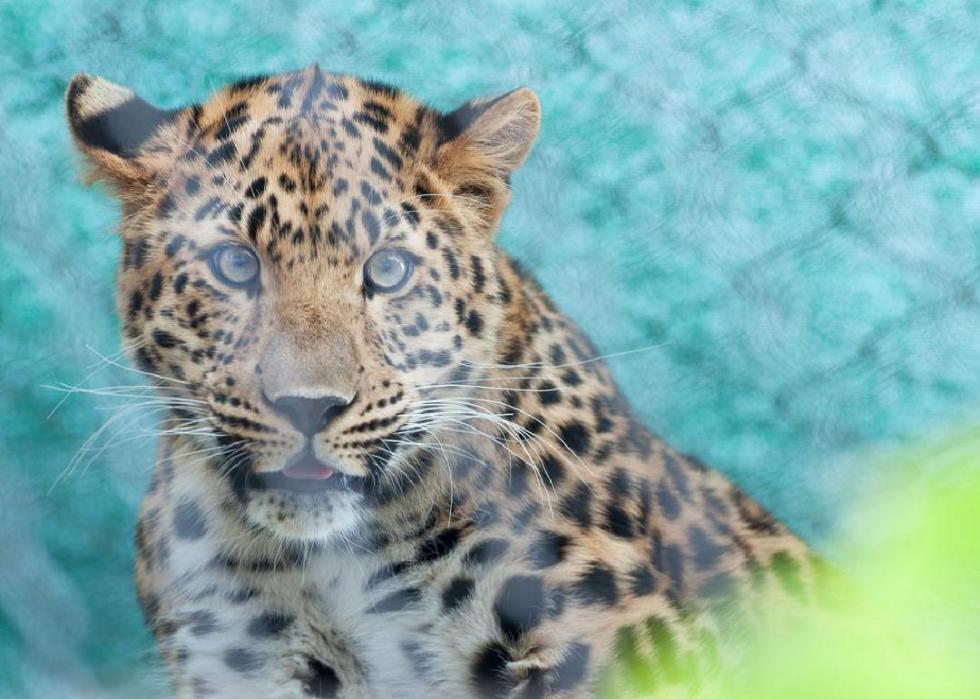
27 / 51
Amur leopard
The critically endangered Amur leopard dwells in temperate and broadleaf forests of far eastern Russia. Colder temperatures and thick snowfall prevent this leopard from expanding northward, and fires take diminished wood encompass, which plays an important function in this big cat's habitat. These felines have been known to jump every bit far as 19 feet horizontally and as high as 10 anxiety.
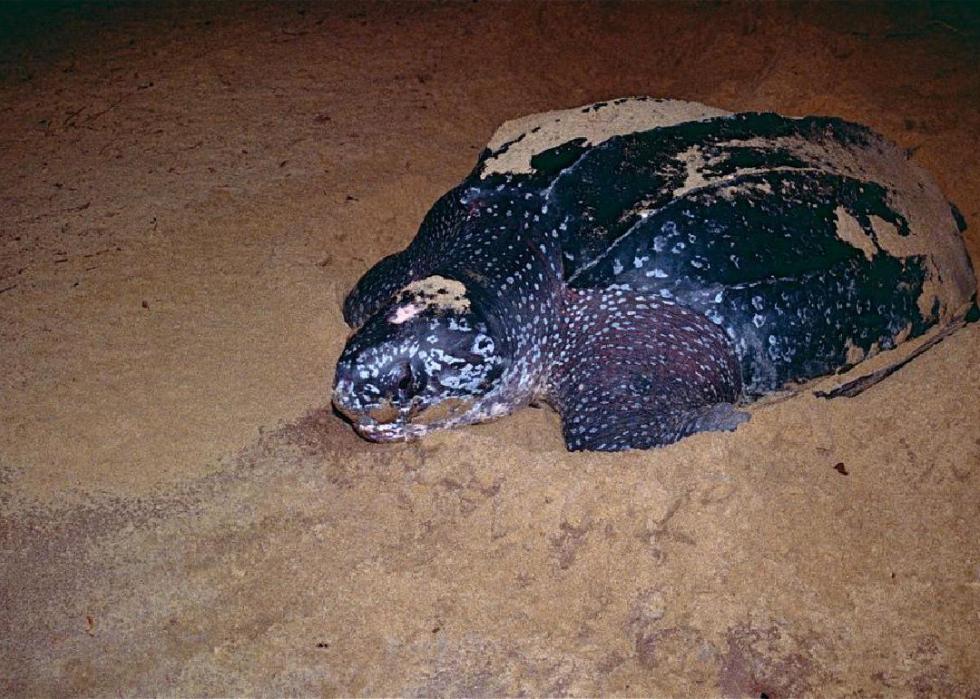
28 / 51
Leatherback sea turtle
The largest species of bounding main turtle, the leatherback is highly migratory and swims across the Atlantic and Pacific oceans. Every summer and fall, Pacific leatherbacks migrate from the Coral Triangle to the coast of California to feast on jellyfish. As is the instance with all sea turtles, rise body of water levels impact egg-laying grounds, and warmer sand temperatures tin can destroy eggs or lead to an overabundance of female turtles. Additionally, these turtles, categorized as vulnerable, feed amid coral reefs and beds of seagrass, which have suffered from acidification and runoff.
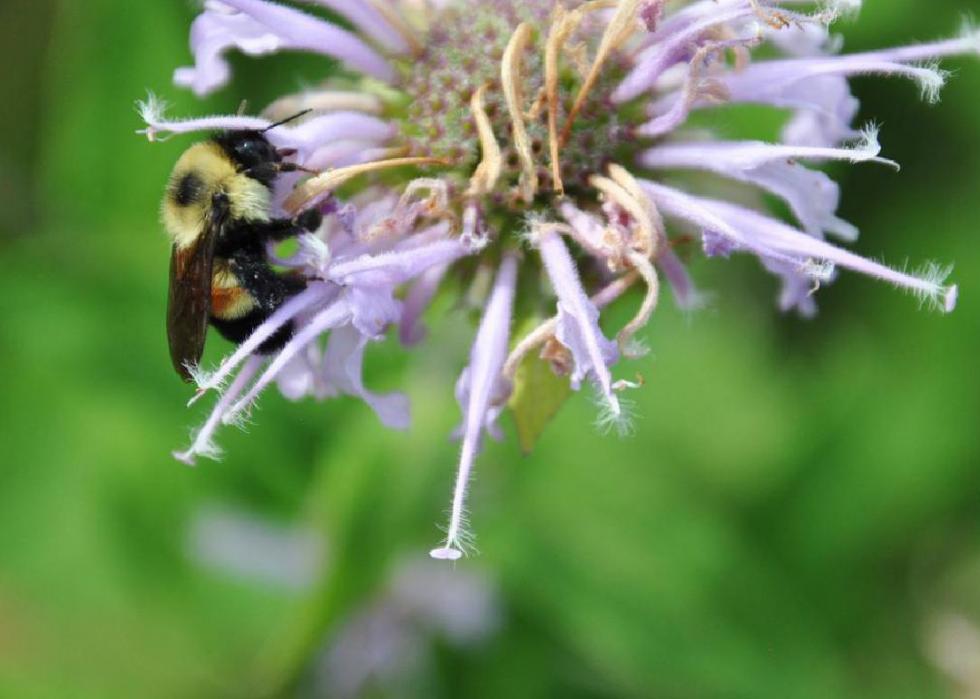
29 / 51
USFWS Midwest Region // Flickr
Rusty patched bumblebee
Though the rusty patched bee was once prevalent in Midwestern and Northeastern U.S. grasslands and tallgrass prairies, it has suffered from habitat loss as those lands have become farms. High temperatures and farthermost pelting—as well as drought and premature snow melting—hinder the flowering of pollinator plants, restrict areas for queens to nest and hibernate, and shorten the time for dearest-gathering. These factors contribute to the rusty patched bee's endangered status, as the species teeters on the brink of extinction.
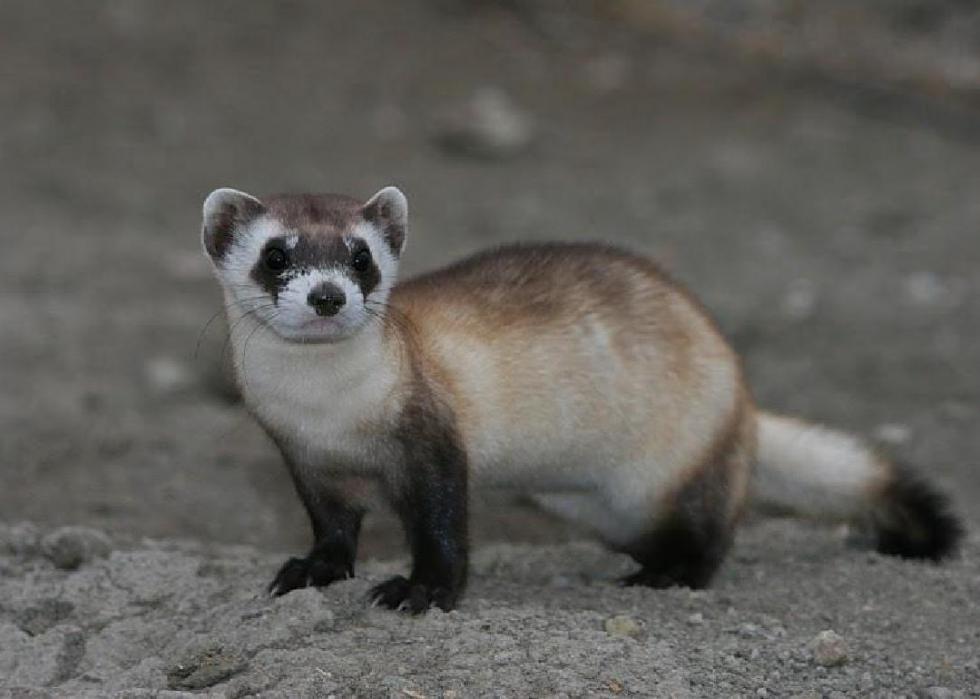
30 / 51
USFWS Mountain-Prairie // Flickr
Black-footed ferret
This ferret species, native to North American forests, was once thought to be extinct, but conservation efforts take given it a second chance. Some 300 ferrets remain today. The endangered ferret'due south principal food source, prairie dogs, have been on the pass up due to affliction, brought about in function past rising temperatures.
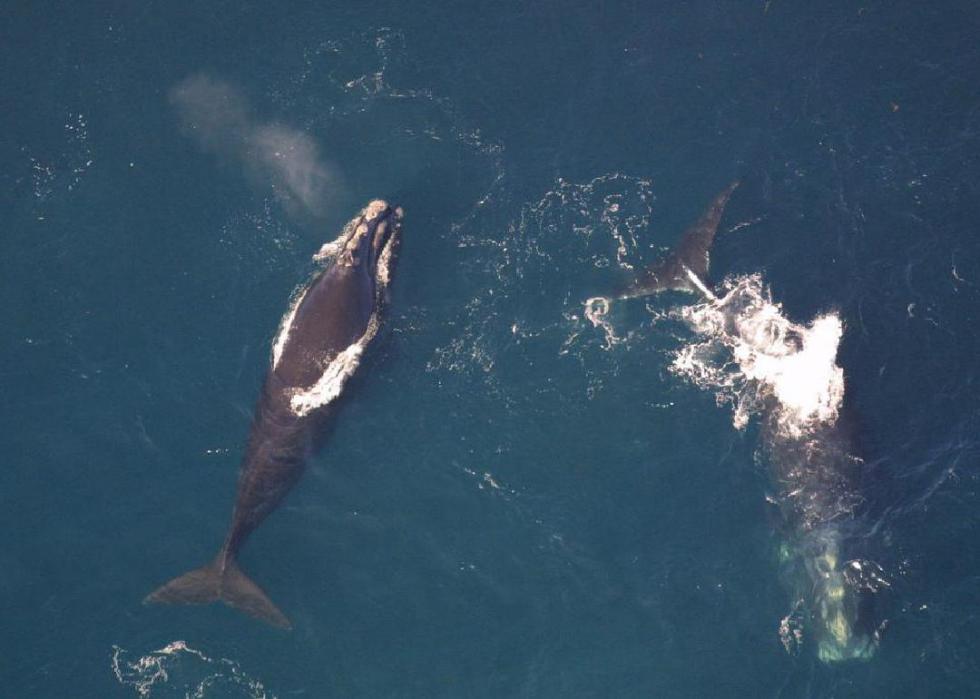
31 / 51
North Atlantic right whale
As its proper noun suggests, the North Atlantic correct whale roams the littoral waters of the eastern United states. Similar to other baleen whale species, information technology is categorized every bit endangered due to increasing ocean temperatures. Warmer waters are killing off whale food supplies similar phytoplankton and krill, but as whales shift northward to find food, limited protection policies increase their risk of being ensnared by ships or line-fishing equipment.
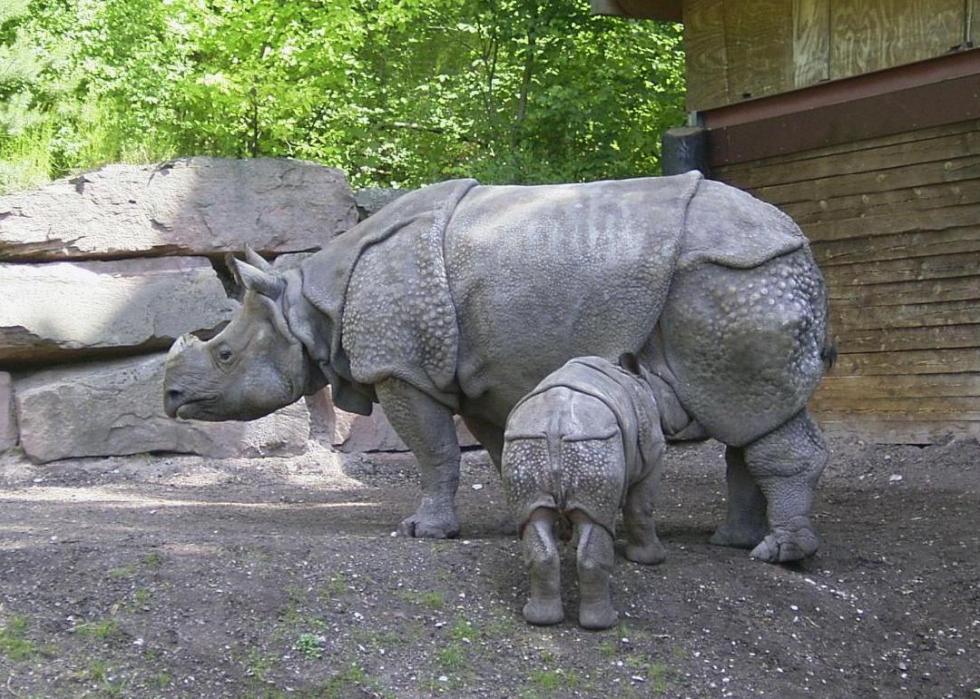
32 / 51
Jo Oh // Wikimedia Commons
Javan rhino
The Javan rhino is the virtually threatened of the five species of rhino. Having one time roamed northeastern Bharat and Southeast Asia, what remains of this species lives in Ujung Kulon National Park in Java, Indonesia. Several climatic factors threaten the critically endangered rhino, such as tsunamis, rising ocean levels, and the potential explosion of the neighboring Anak Krakatau volcano.
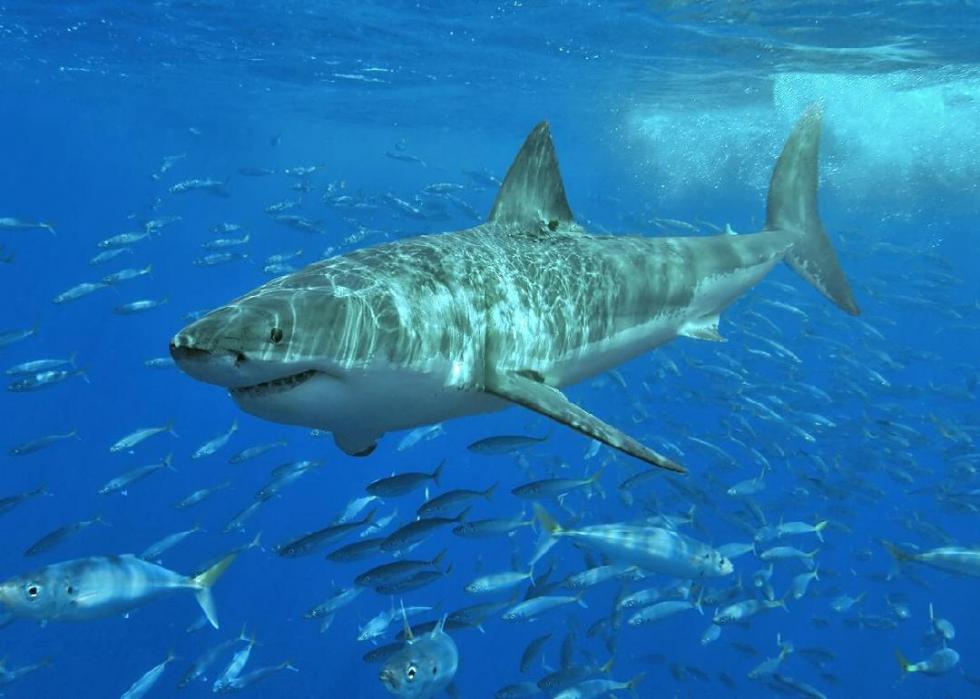
33 / 51
Terry Goss // Wikimedia Commons
Great white shark
The largest of the predatory fish, the great white shark populates waters off the coast of California, southern Chile, East Africa, and the Galapagos. Researchers are still piecing together the effect of climate change on sharks, just rising sea temperatures and acidification take been tampering with fish and marine mammals that sharks eat. The changing conditions have also been impacting shark migration and breeding patterns. Though great whites are highly migratory, they are tiresome to conform to changing climates, which partially contributes to their status as vulnerable.
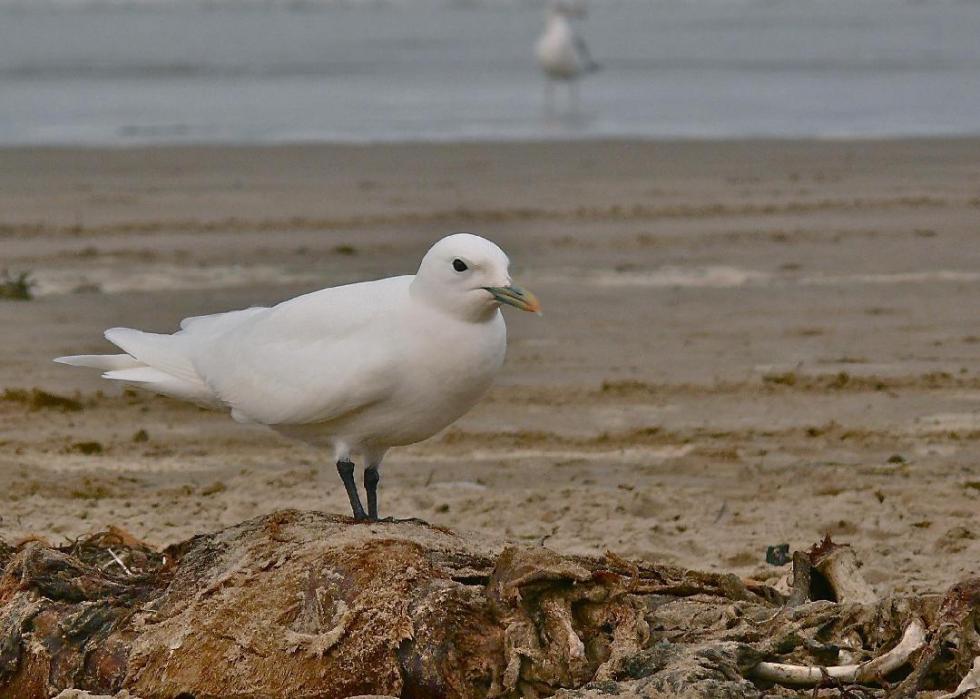
34 / 51
Linda Tanner // Wikimedia Commons
Ivory gull
This rare arctic bird can exist plant on ocean ice off the coasts of Greenland and Canada, where information technology is categorized as vulnerable and endangered, respectively. Continued loss of sea ice is 1 of the reasons for this gull's decline. They rely on thick, concentrated water ice for successful convenance and feed on finfish and shellfish that live close to the surface of the ice.
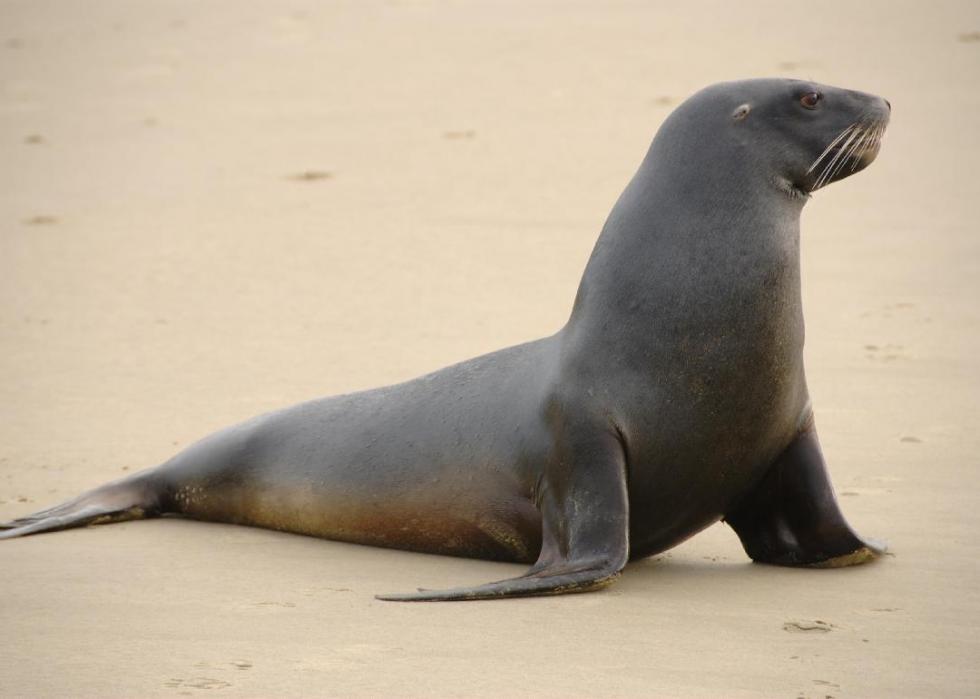
35 / 51
Karora // Wikimedia Commons
Ocean lion
Like and then many other chill creatures from fish to polar bears, bounding main lions are considered endangered due to the gradual disappearance of sea water ice. As melting ice leads to rising body of water levels, sea lions are left with fewer places to breed, whether on ice or on beaches. Less state area amid the oceans doesn't bode well for bounding main panthera leo pups, every bit they are more than exposed to the elements and risk becoming separated from their mothers. As warming h2o alters fish habitats, sea lions too take to travel further for nutrient.
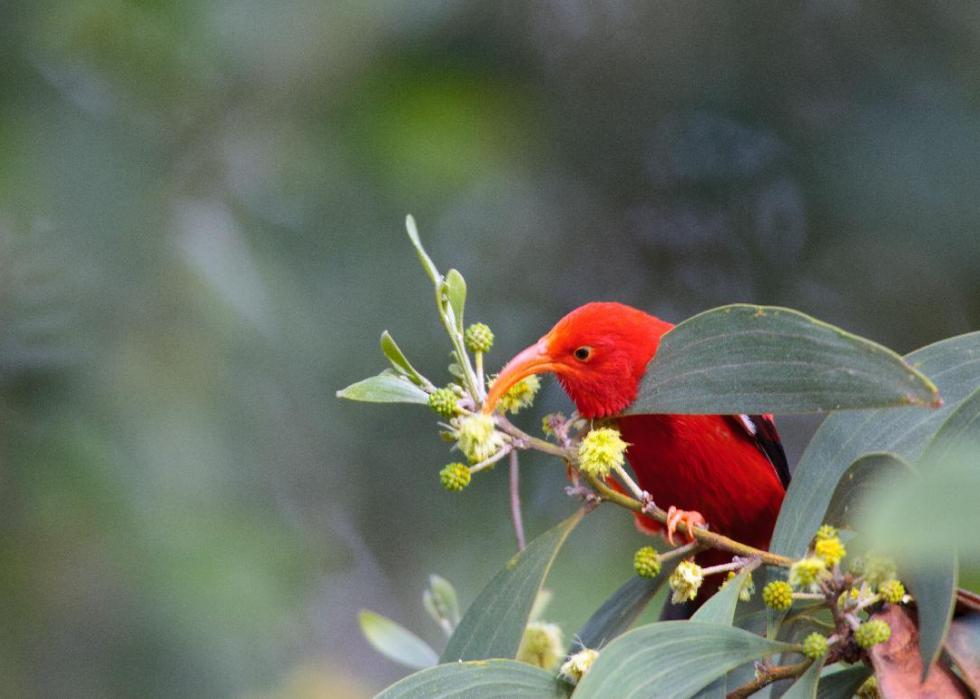
36 / 51
Ludovic Hurlimann // Wikimedia Commons
Hawaiian honeycreeper
Native to Kauai mountain forests, the honeycreeper has go prey to malaria-ridden mosquitoes, which have become more arable due to spiking temperatures. These mosquitoes are likewise impeding the bird's geographic range, further driving their dive toward extinction. The 'akikiki is i of the well-nigh threatened species of honeycreeper, categorized as critically endangered.
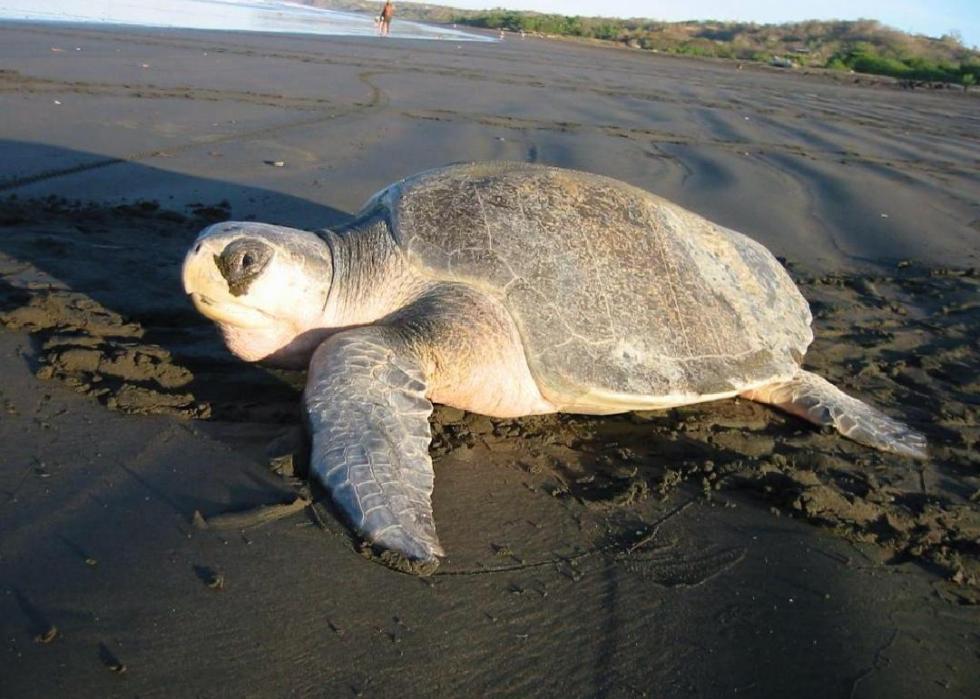
37 / 51
Brad Flickinger // Flickr
Olive ridley turtle
Classified as vulnerable, the olive ridley is no different from whatever other aquatic turtle when it comes to climate change. As sea levels continue to pitter-patter up, this turtle'southward nesting areas become compromised and warmer sea surface temperatures can impinge on feeding grounds. And, again, the warmer the beaches get, the more female turtles will hatch, throwing sex ratios off kilter.
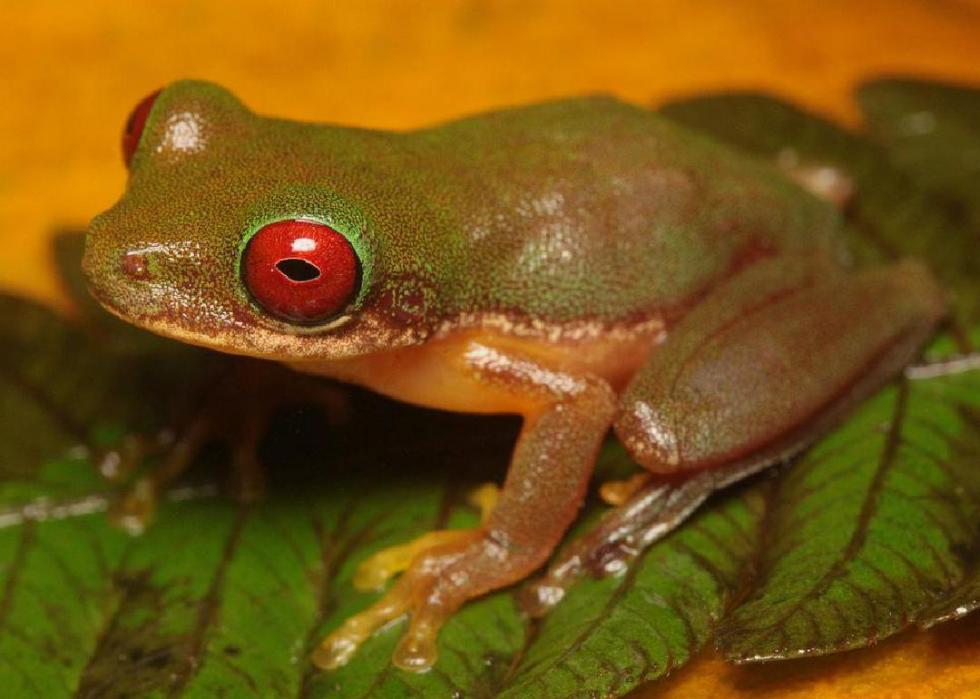
38 / 51
Honduran brook frog
Every bit its proper name indicates, this tropical frog is native to the rainforests of Honduras. It'southward critically endangered due to storm interference with clear h2o streams, and it'south likewise threatened by water pollution and fires. Warming temperatures play a part in the spread of the mortiferous chytrid fungus, responsible for many amphibian deaths.
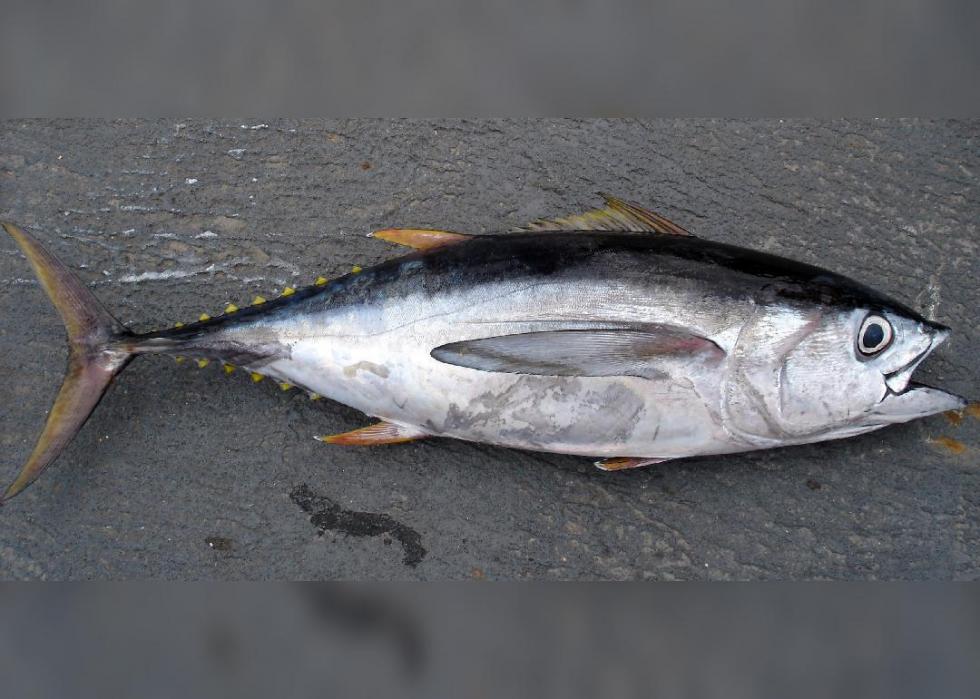
39 / 51
Allen Shimada // Wikimedia Commons
Bigeye tuna
Found in tropical and subtropical waters of the Atlantic, Indian, and Pacific oceans, the bigeye tuna has begun to refuse due to a reduction in phytoplankton—which is, in turn, due to warming ocean temperatures. Because that phytoplankton plays a crucial role in oxygen production, information technology is no wonder this vulnerable tuna species has been struggling.
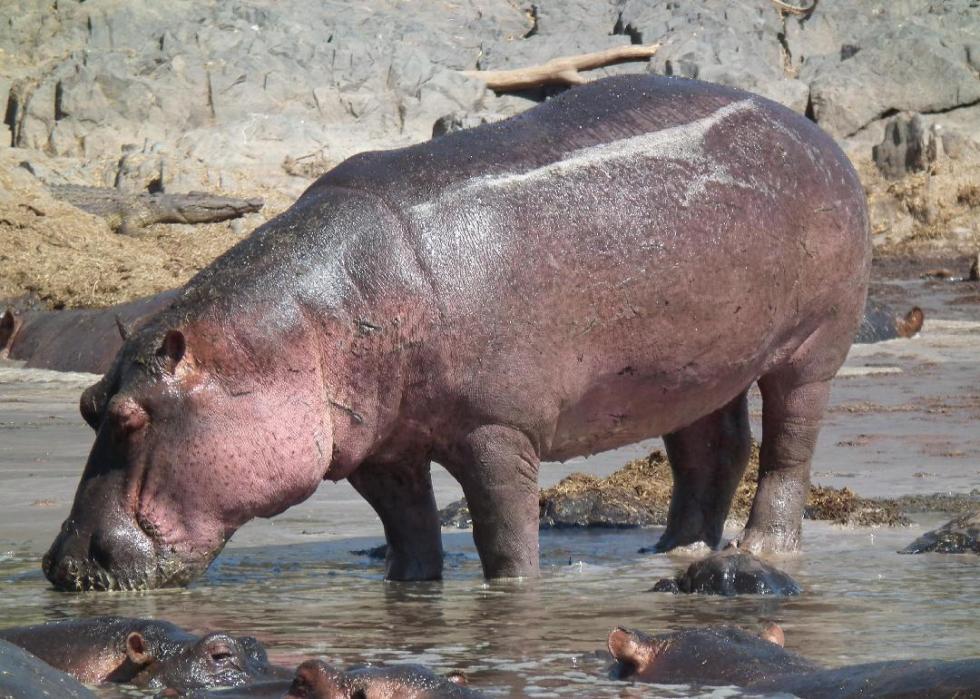
40 / 51
Nevit Dilman // Wikimedia Commons
Hippopotamus
Residing along the rivers and lakes of sub-Saharan Africa, hippos have become a vulnerable species due to rising temperatures drying up bodies of water, which absurd and hydrate the animals. Equally freshwater supplies diminish, and then does some of the vegetation that hippos eat.
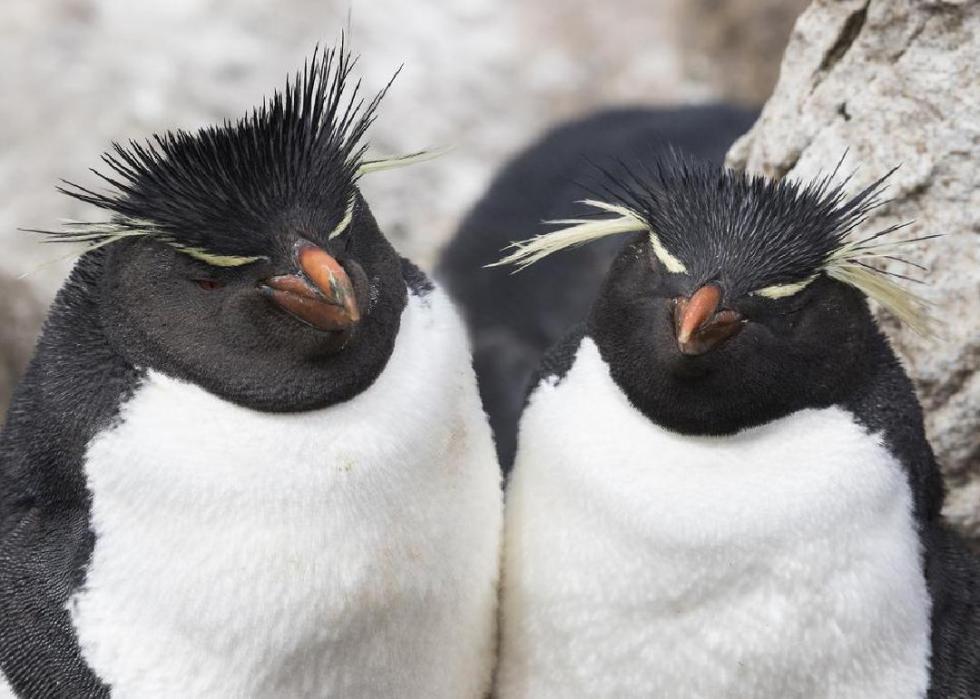
41 / 51
Gregory "Slobirdr" Smith // Flickr
Southern rockhopper penguin
Named for their tendency to hop from rock to stone in the sub-Antarctic islands of Africa, Southward America, Australia, and New Zealand, rockhoppers are threatened past warming body of water-surface temperatures, which dethrone their casualty populations. These vulnerable seabirds have decreased by over 90% since the 1940s.
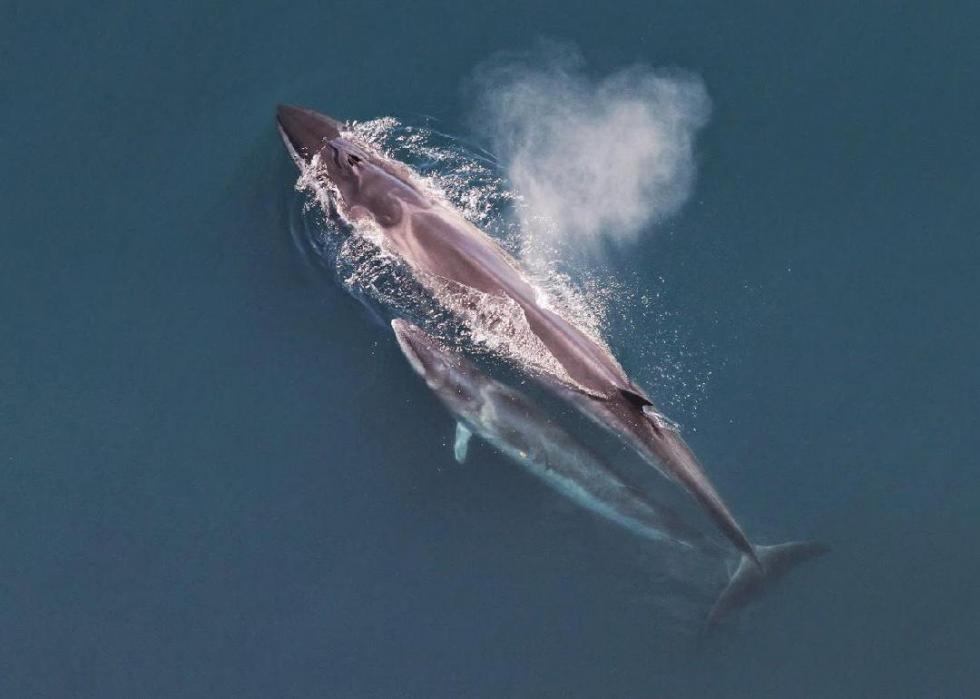
42 / 51
Christin Khan // Wikimedia Commons
Sei whale
The sei whale is native to all non-tropical and non-polar oceans and seas. As is the case for many other marine animals, warming ocean waters are partly to blame for the sei's endangered status; they tend to feed in cooler waters, so their feeding patterns may be at risk every bit bounding main temperatures rising. Ocean acidification too comes into play, every bit it impacts the evolution of some of the whale's food sources, such as modest shellfish. This acidification can too lead to an increase in harmful algae blooms, which kickstart a vicious cycle—the sei whale'south casualty swallow the toxic algae, so when the whale eats that prey, it becomes sick and potentially dies.
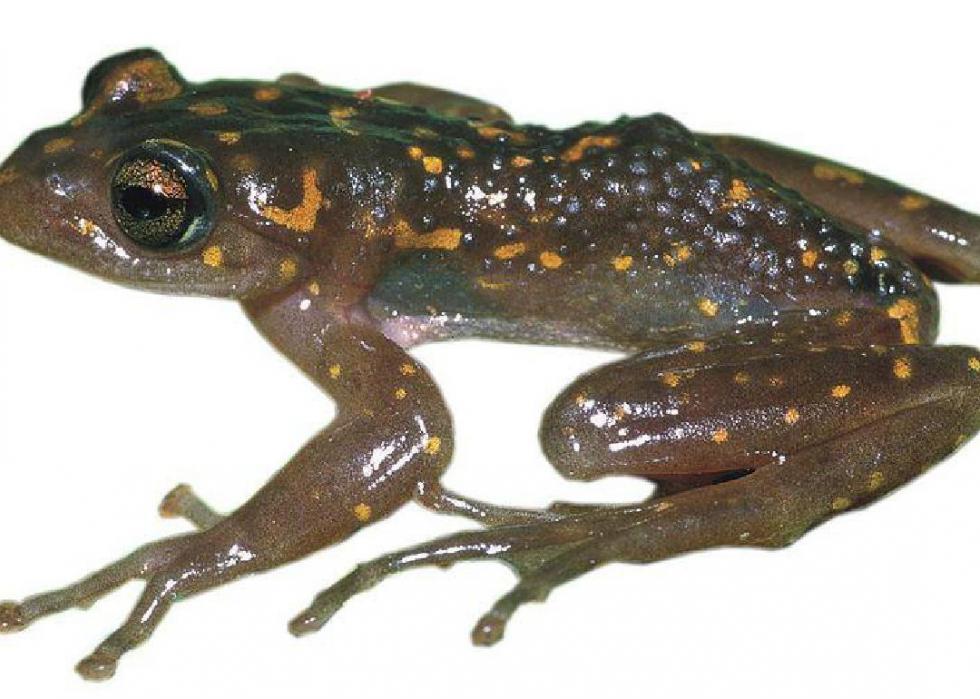
43 / 51
Williams vivid-eyed frog
Classified equally critically endangered, this frog lives at loftier altitudes in limited areas of Madagascar. Mountain-abode frogs such as these lay their eggs amid moist leaf textile in cloud forests. But as temperatures outset to rise at higher altitudes, clouds are edging farther upward and leaves are drying up, leaving fewer nesting places for the frogs. They can migrate only and then far up a mountain before they go stranded.
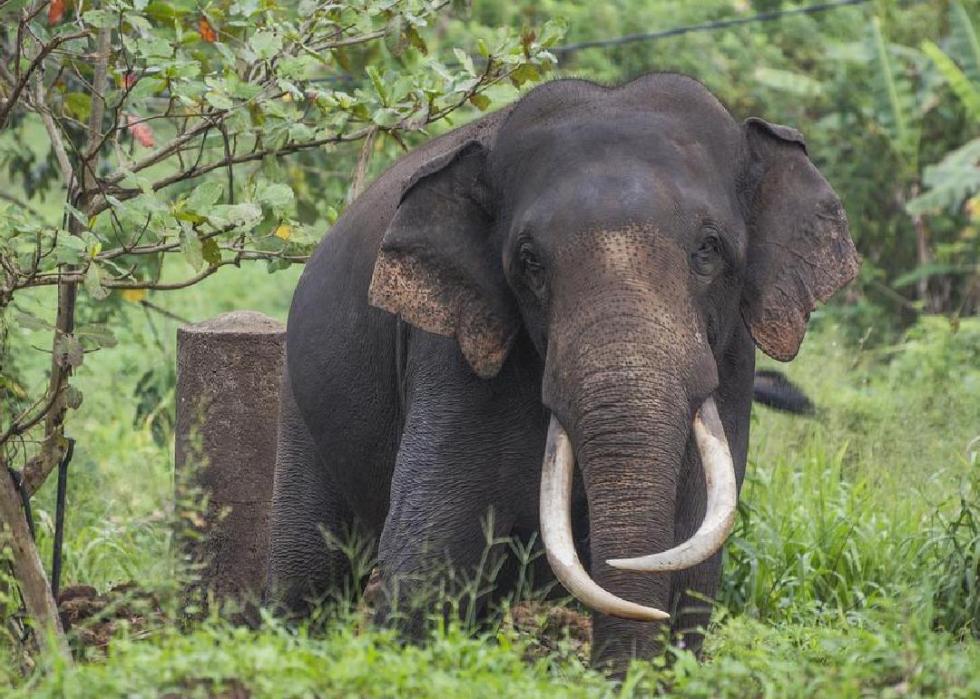
44 / 51
Sri Lankan elephant
The largest of the Asian elephant subspecies, Sri Lankans were once abundant in tropical and subtropical forests of the isle southeast of India, but have been squeezed into smaller areas due to wood conversion and agronomical needs. Warming temperatures make h2o sources, which elephants need to function properly, scarce in dry seasons. These environmental factors, plus human hunters, contribute to the animal's endangered status.
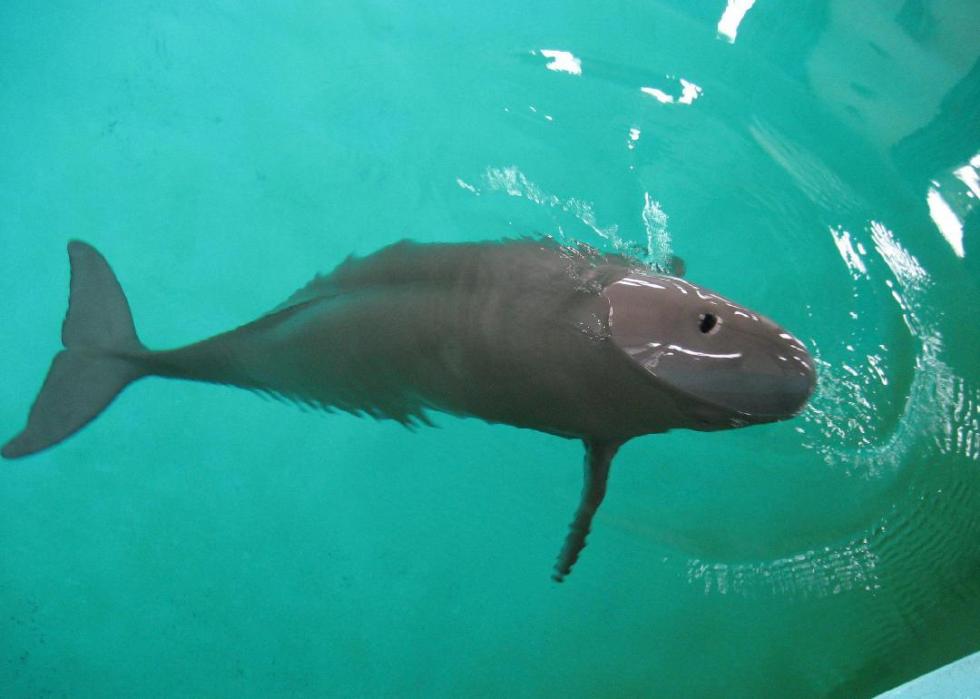
45 / 51
Yohkawa // Wikimedia Commons
Yangtze finless porpoise
This critically endangered porpoise has had to endure dips in overflowing retentivity chapters and inadequate water supply in its native Yangtze River Basin in China. Scientists predict that the melting of glaciers in the Qinghai-Tibetan plateau, the source of the Yangtze River, will ultimately crusade h2o sources to dwindle.
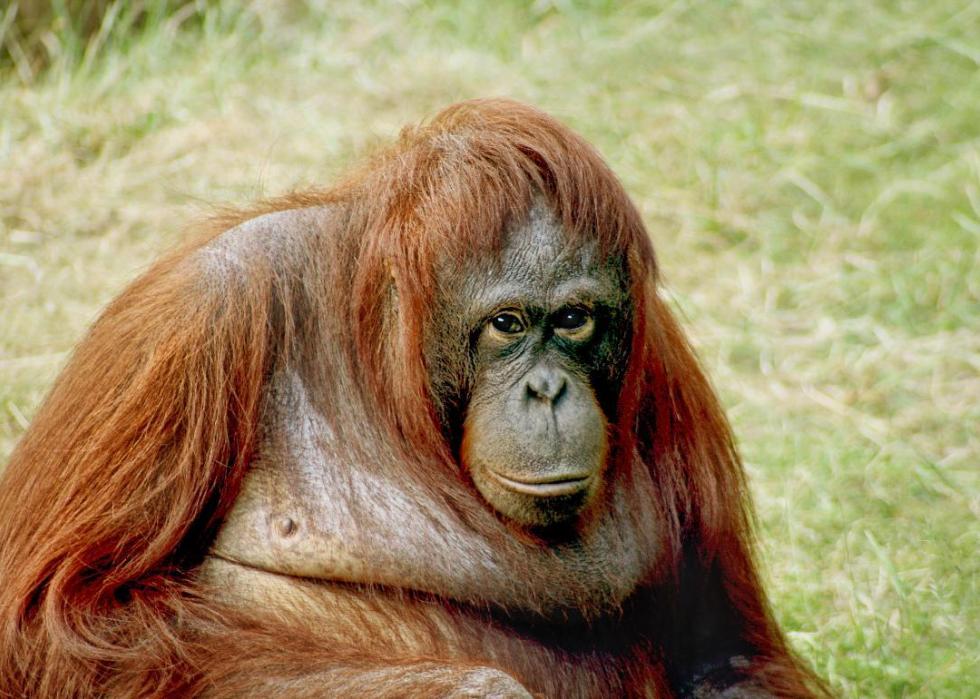
46 / 51
Julielangford // Wikimedia Commons
Orangutan
Orangutans are native to rainforests in the Southeast Asian islands of Kalimantan and Sumatra. A couple of climatic factors play a office in the orangutan'due south critically endangered status. Changing temperatures and rainfall patterns alter where these animals tin observe tree fruits and leaves vital to their diets. Plus, food scarcity leads to lower reproduction rates. Drier conditions has acquired more fires in Borneo, which has led to fragmentation of their habitat.
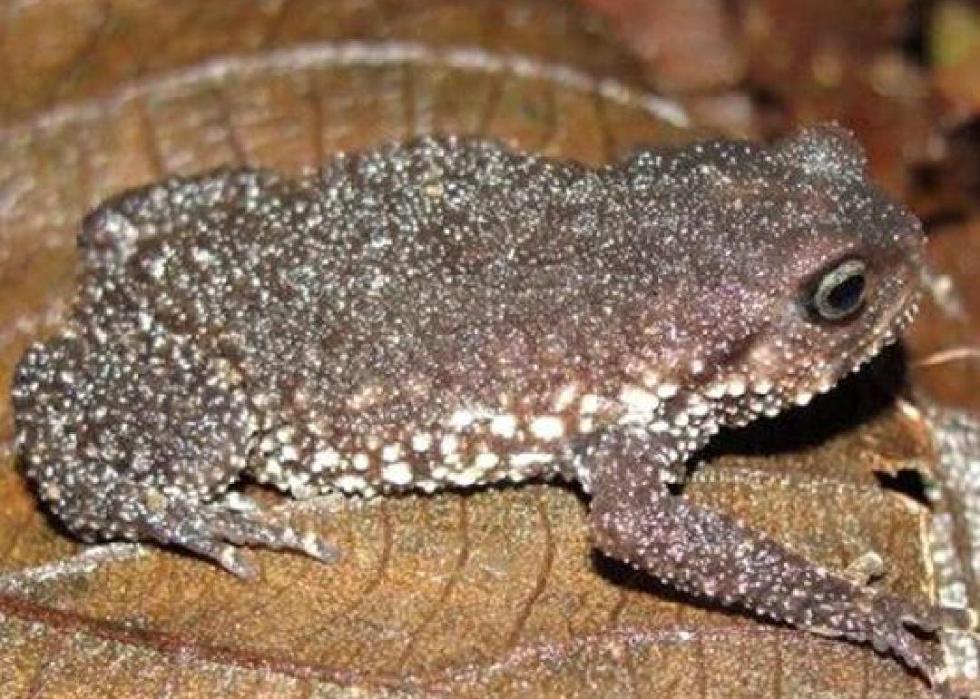
47 / 51
Patrick Kinyatta Melonza // Wikimedia Eatables
Taita Hills warty frog
This bulbous-bodied, critically endangered frog is native to forest patches in Kenya. Like the Williams bright-eyed species, this warty frog is threatened past rising temperatures that dry up leaf litter and bodies of h2o, leaving fewer places for frogs to lay eggs and survive as tadpoles.
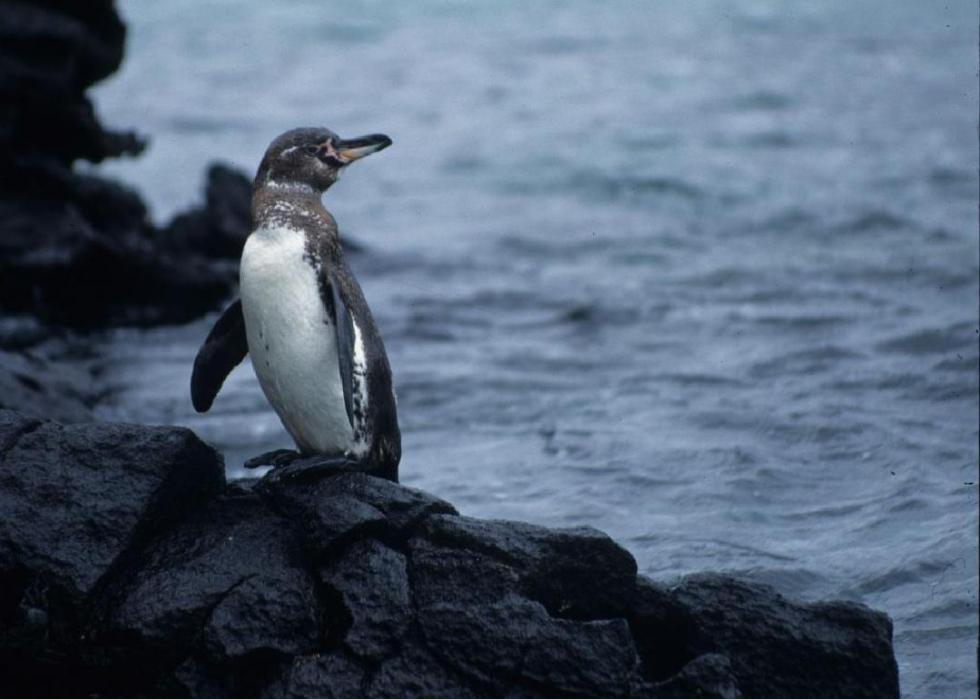
48 / 51
Galapagos penguin
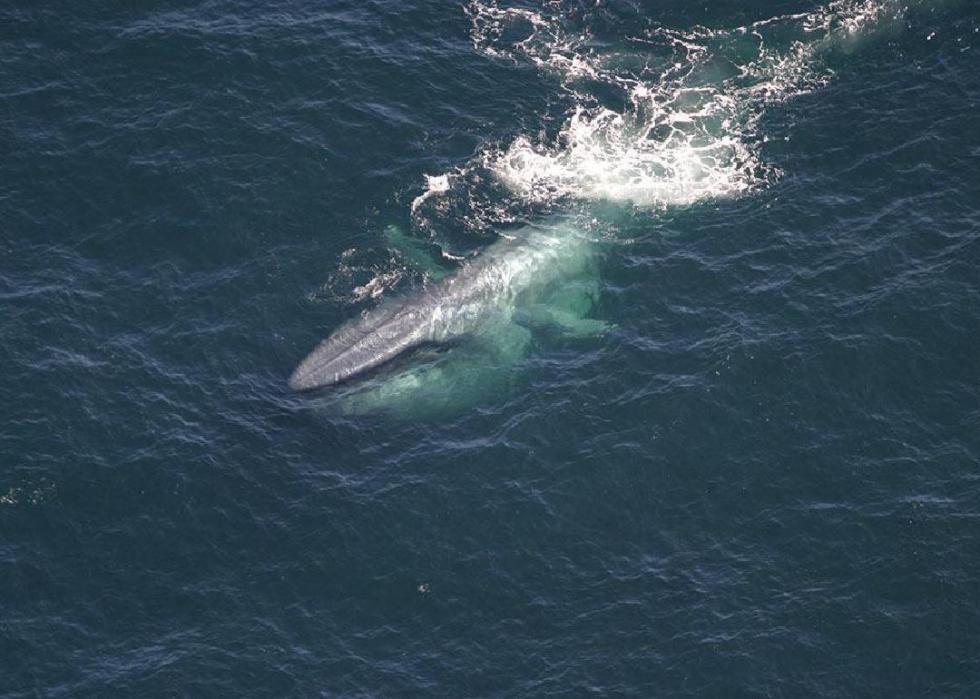
49 / 51
NOAA Fisheries/Lisa Conger // Wikimedia Commons
Blue whale
The largest fauna on Earth, the blue whale populates oceans of southern Republic of chile, the Gulf of California, and the Coral Triangle. The instance of this marine giant is no different than that of many other ocean creatures. Warming temperatures and the melting of Antarctic ice are diminishing krill populations, the blueish whale's main nutrient source. The disappearance of ice leads to fewer ocean algae in warmer seasons and therefore less food for krill. These endangered whales are not merely the largest, simply as well the loudest animal in the globe; their calls can ramp up to 188 decibels.
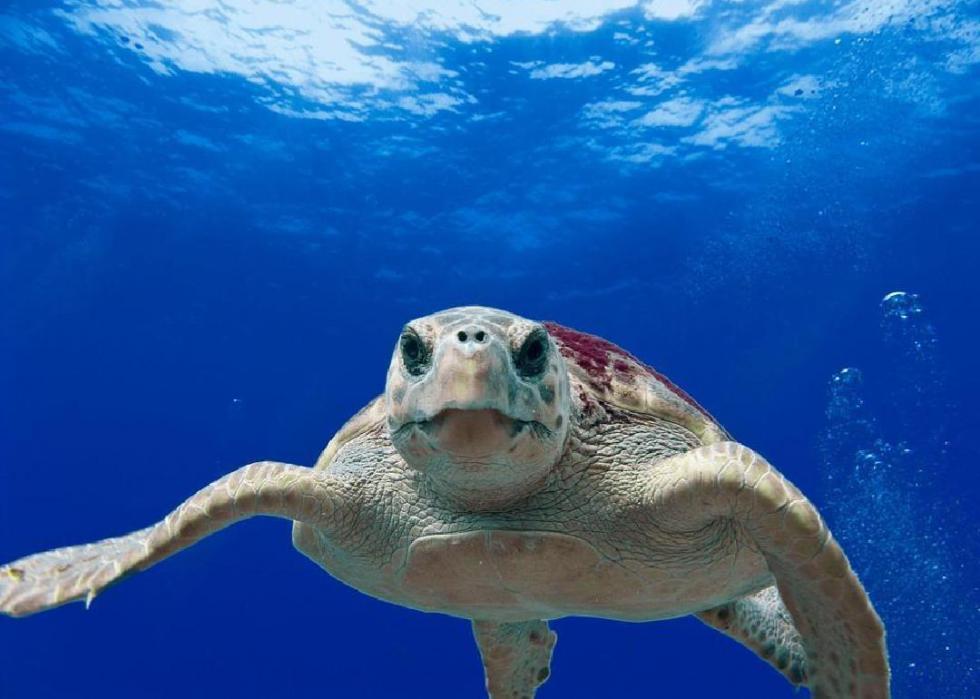
50 / 51
Loggerhead turtle
Loggerheads can be plant on beaches and oceans in coastal Due east Africa, the Gulf of California, the Mesoamerican Reef, and the Coral Triangle. Irresolute climate impacts these vulnerable loggerheads similarly to other sea turtle species. Rising ocean levels and extreme weather can limit sea turtle nesting grounds. Warmer temperatures are leading to more than frequent female person sea turtle births and generally impede on hatching rates. Finally, warmer waters alter bounding main currents, on which bounding main turtles rely when they migrate.
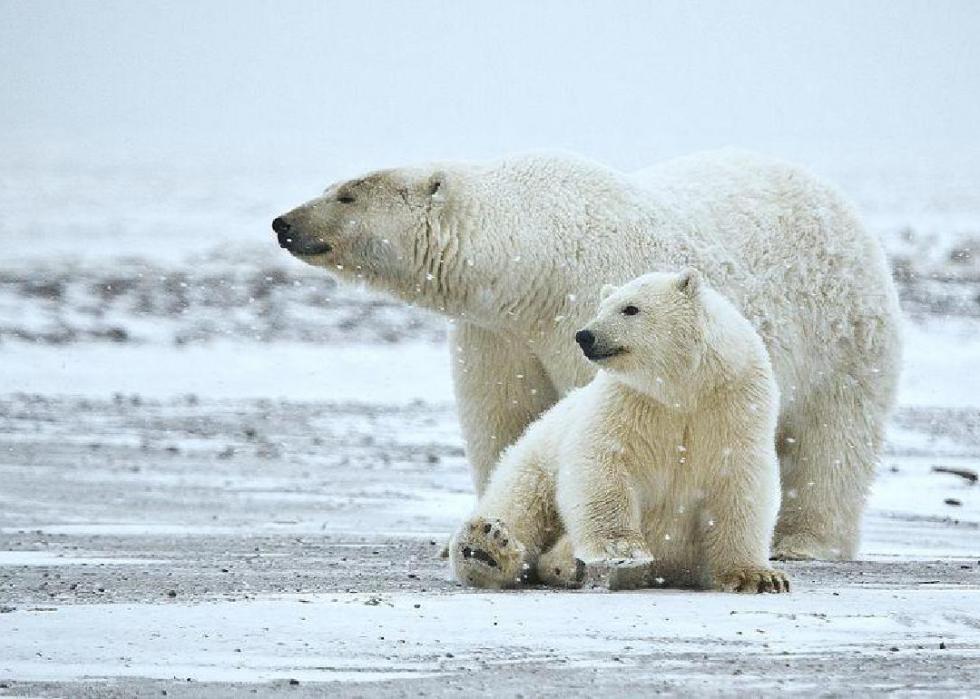
51 / 51
Alan D. Wilson // Wikimedia Commons
Polar carry
These ivory giants spend most of their time on sea ice in the Arctic Ocean. Increasing temperatures are melting bounding main ice, a vital part of the polar conduct'due south habitat and power to survive. These bears carry out virtually all of their activities on water ice, such as hunting, reproducing, and migrating. Plus, their diet consists mainly of ringed and bearded seals, who also rely on ice to thrive. Ice-melting opens new possibilities for oil and gas exploration—a further threat to polar bears.
You may also similar:How climatic change has affected each country
Trending Now
© Stacker 2022. All rights reserved.
Source: https://stacker.com/stories/1771/polar-bears-and-50-other-species-threatened-climate-change
Posted by: seasedeaders50.blogspot.com

0 Response to "What Are Some Animal Populations That Will Be Harmed By Climate In Change"
Post a Comment